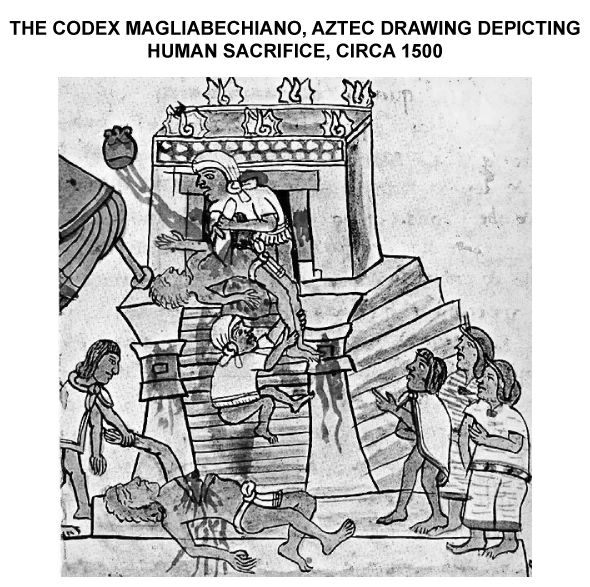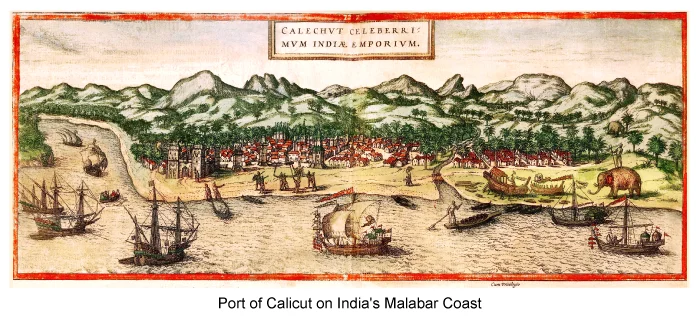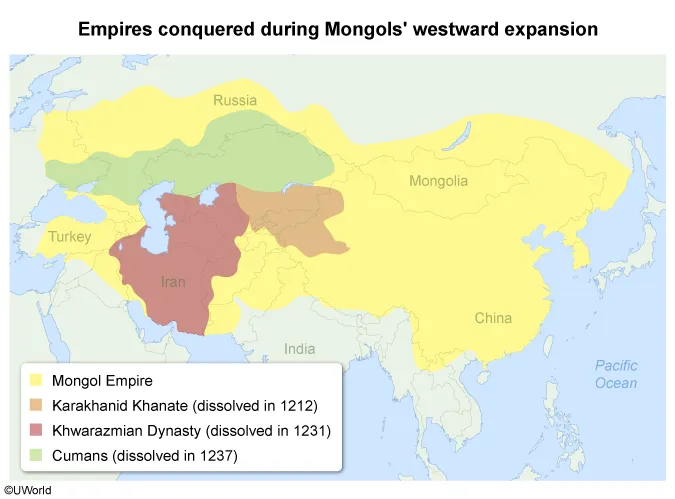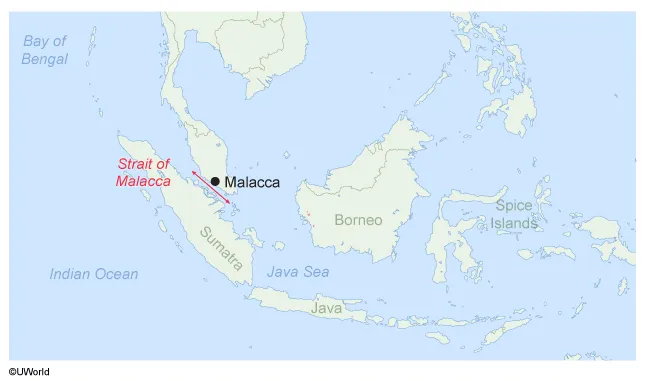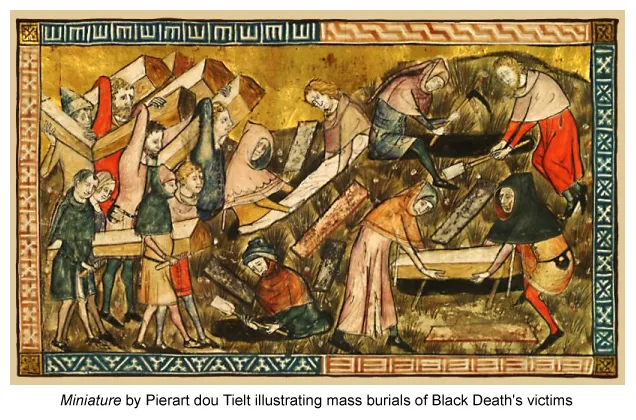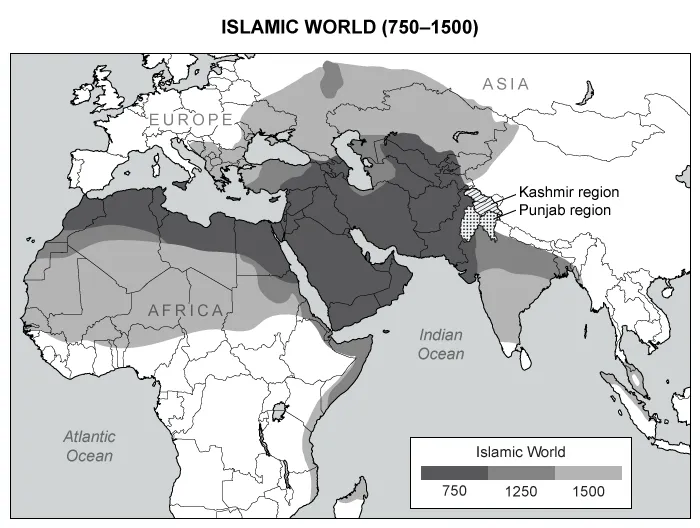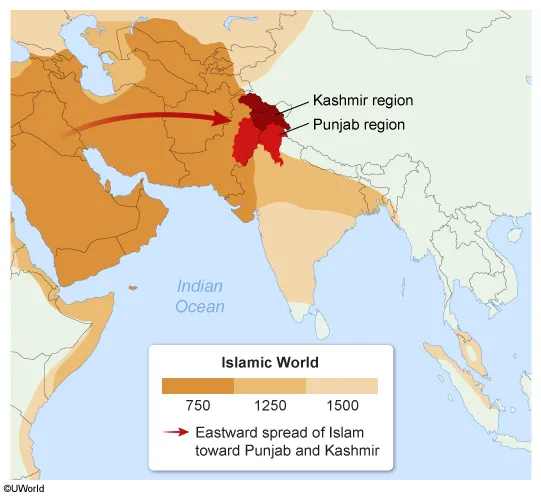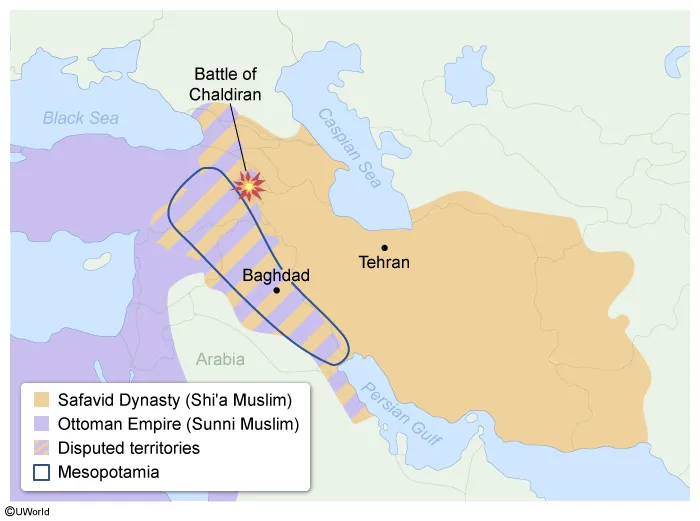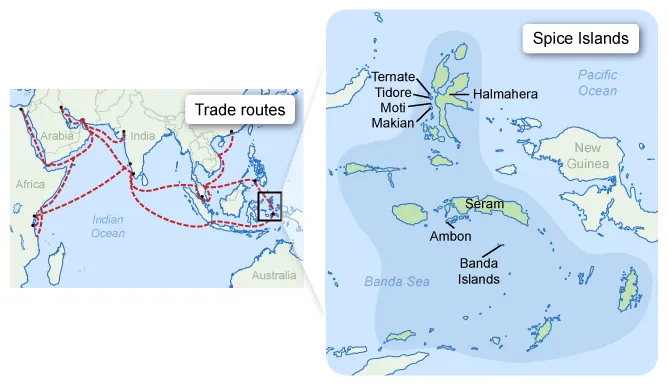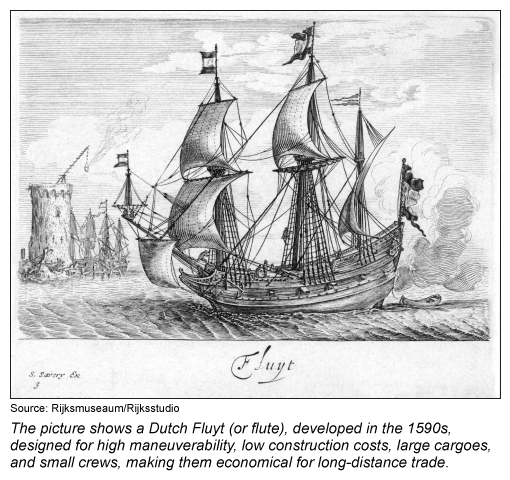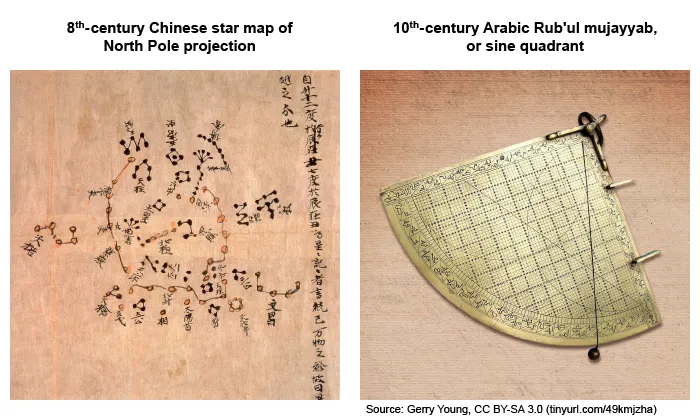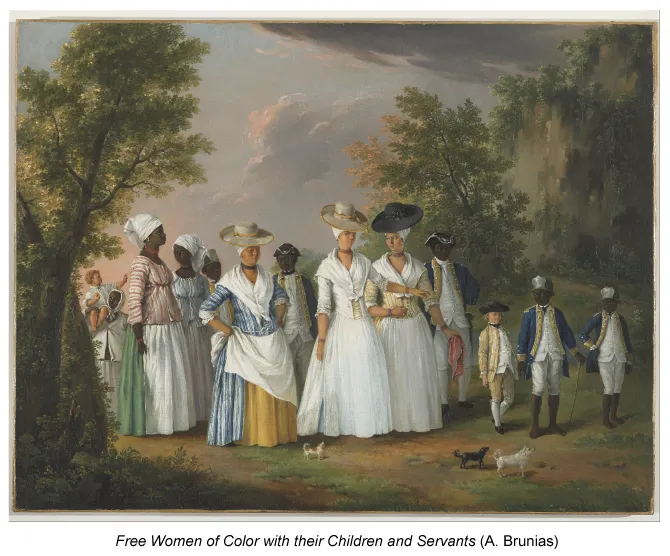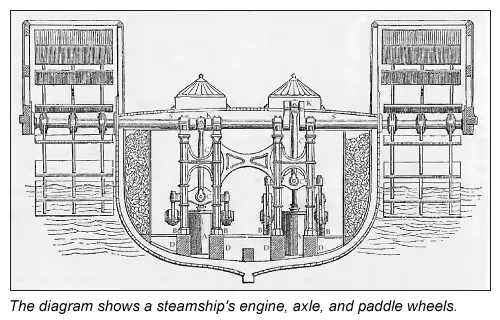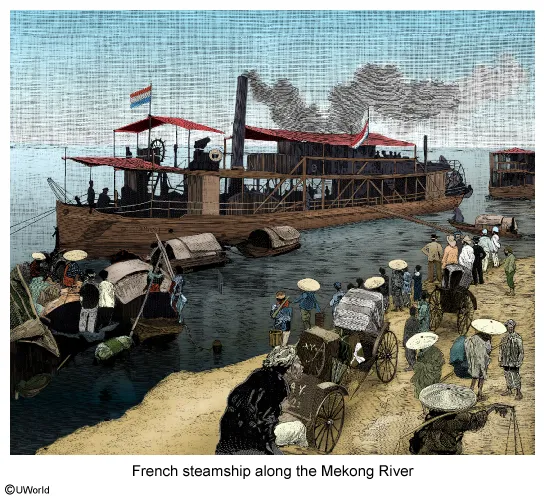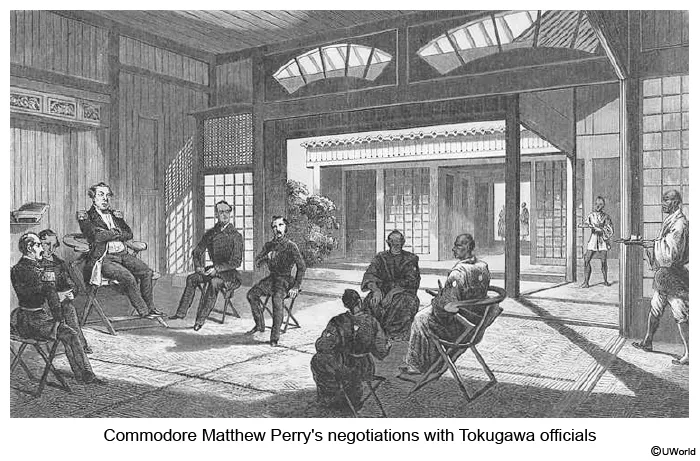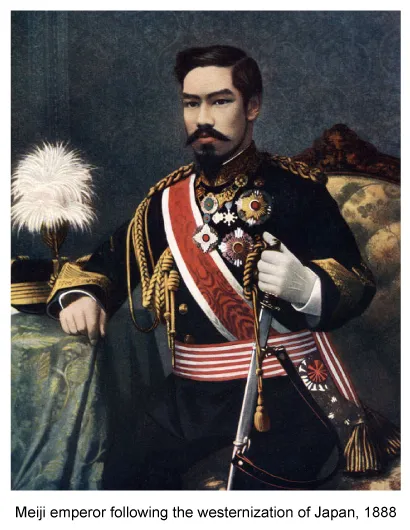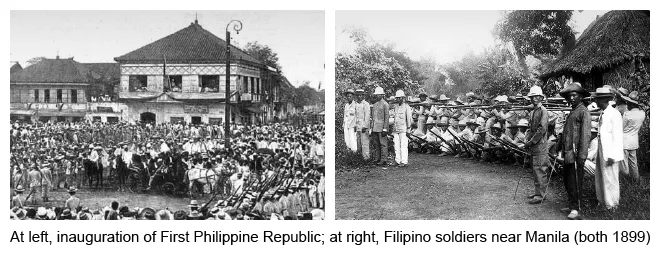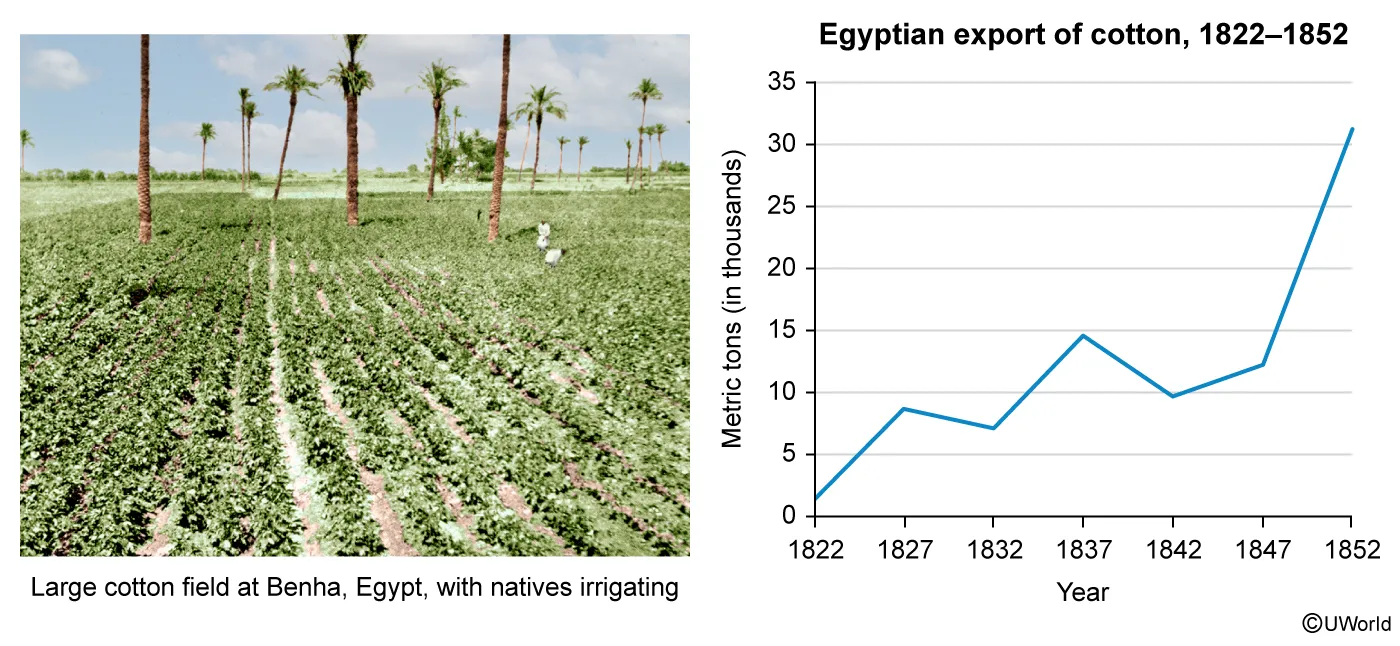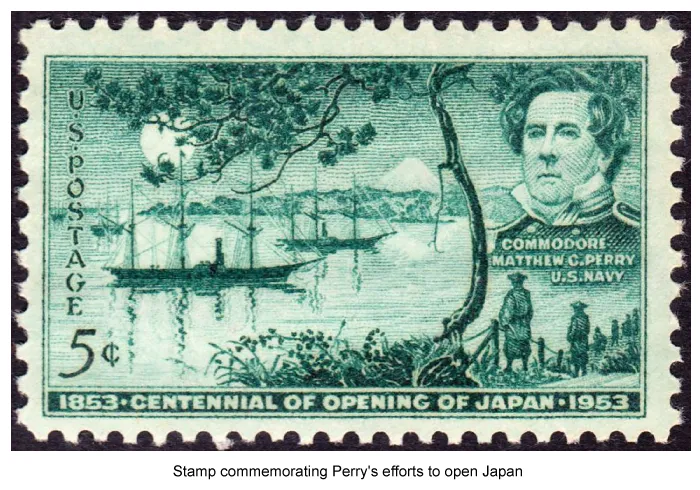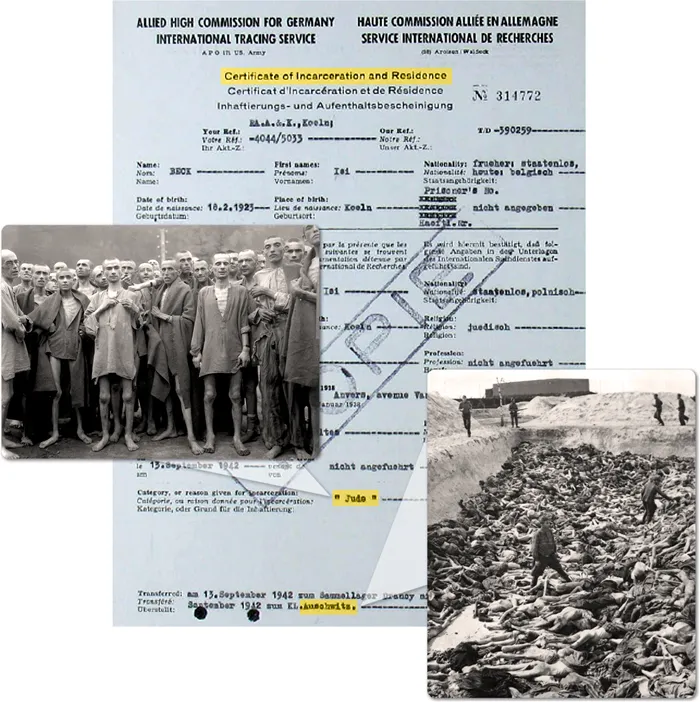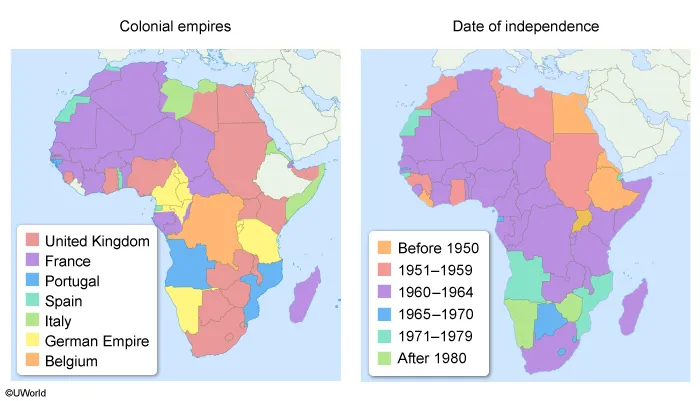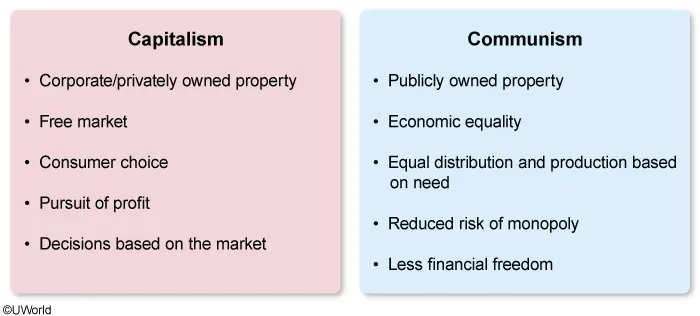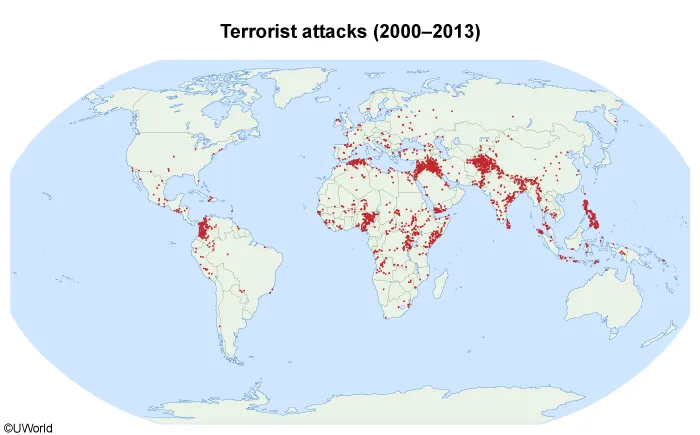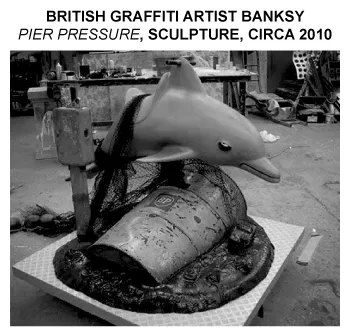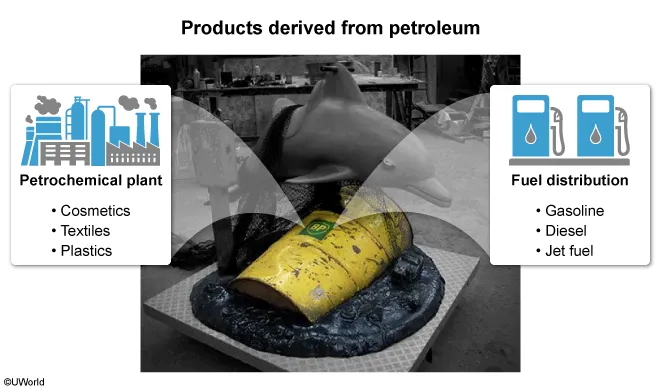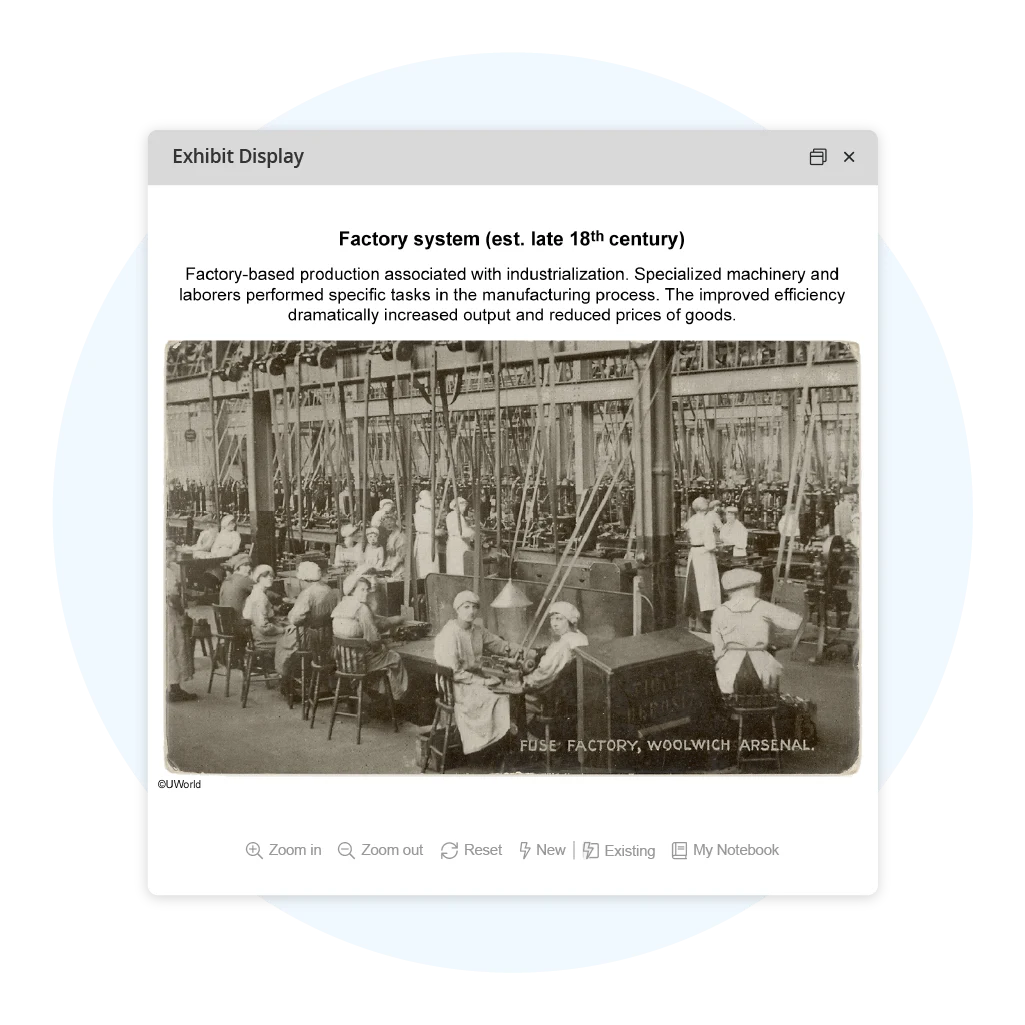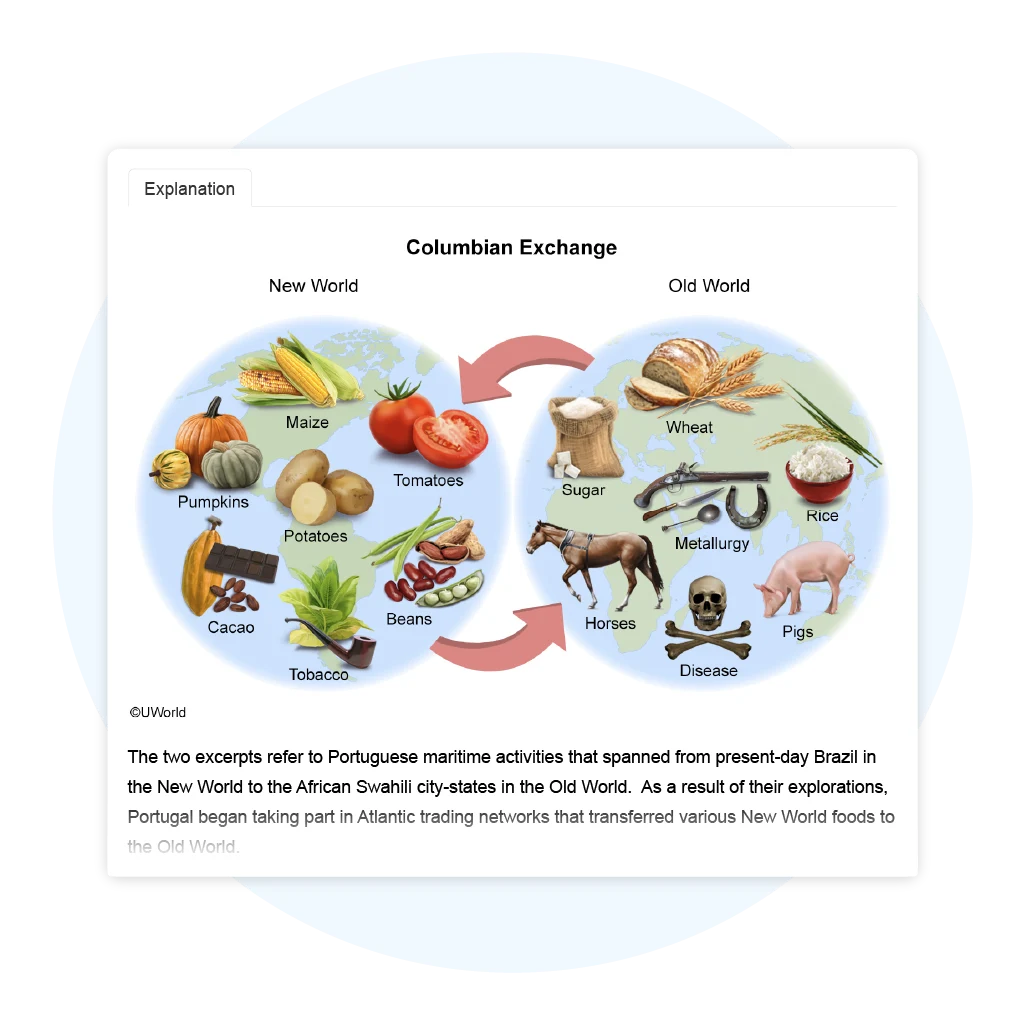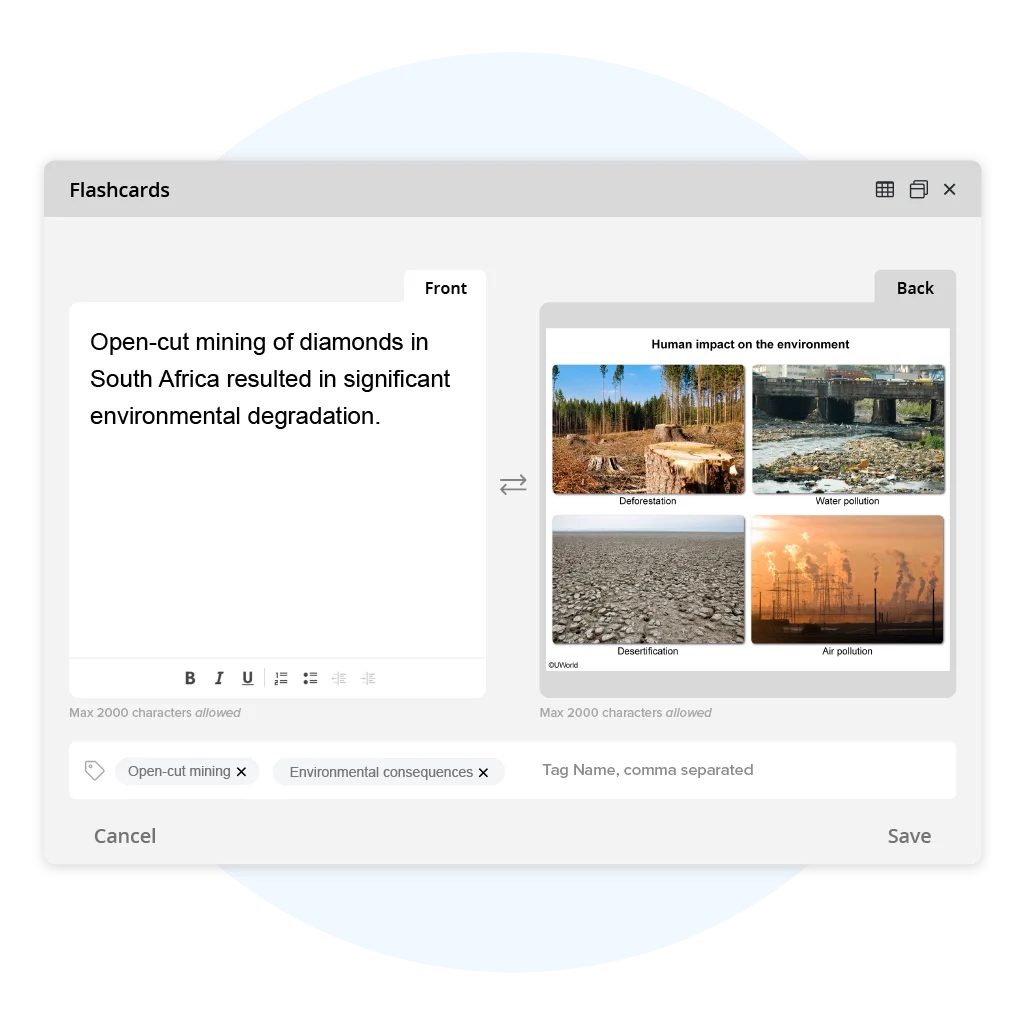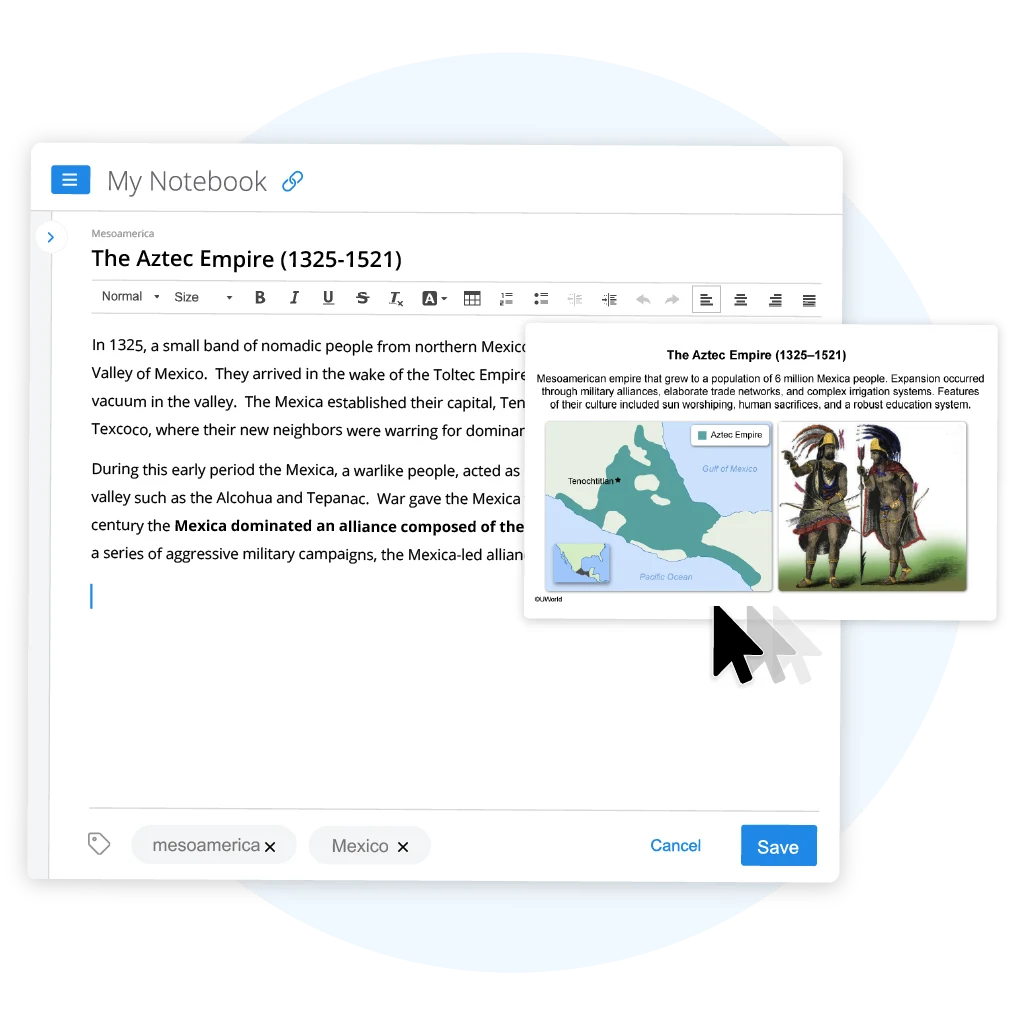AP® World History Practice Tests & Questions
Ace the AP® World History exam with 500+ multiple-choice questions and realistic FRQs (free-response questions)* written by experienced AP World History educators and exam graders. Build unlimited quick quizzes and targeted practice tests on any historical era, theme, or skill—or create up to 8 full-length, 60-question APWH practice exams. Unlike basic answer keys that leave you guessing, get clear step-by-step explanations, timelines and visuals that bring history to life, and progress tracking that highlights exactly where you need more review. Study smarter, retain more, and score higher.
Try These AP World History Practice Questions for Free
APWH Unit 1 Practice Test: The Global Tapestry (c.1200 to c.1450)
Question
Which of the following directly enabled the establishment of the empire that produced the image?
| A. The collapse of the tribute system in Mesoamerica under the stress of internal rebellions | |
| B. The prohibition of cannibalism and infanticide in Mesoamerica during Spanish colonial rule | |
| C. Prolonged drought as a result of climate fluctuations in the fifteenth century | |
| D. Rapid territorial expansion in Mesoamerica due to aggressive military campaigns during the fifteenth century |
Explanation
In 1325, a small band of nomadic people from northern Mexico—the Mexica—migrated south to the Valley of Mexico. They arrived in the wake of the Toltec Empire's collapse, which had created a power vacuum in the valley. The Mexica established their capital, Tenochtitlan, in the shallow waters of Lake Texcoco, where their new neighbors were warring for dominance.
During this early period the Mexica, a warlike people, acted as mercenaries for powerful groups in the valley such as the Alcohua and Tepanac. War gave the Mexica wealth and respect, and by the 15th century the Mexica dominated an alliance composed of the peoples of the Valley of Mexico. Through a series of aggressive military campaigns, the Mexica-led alliance established the Aztec Empire.
Within a hundred years, the Aztec Empire conquered most of Mesoamerica. Through rapid territorial expansion, the Empire increased its power through taxes, tribute, and trade. The city of Tenochtitlan grew, and the Aztecs recorded their accomplishments, rituals, and other empire inner workings in books known as codices.
(Choice A) Despite rebellions, the Mesoamerican tribute system grew as the Aztec Empire expanded.
(Choice B) The Aztec Empire was established prior to Spanish colonial rule, so there were no Spanish prohibitions that would have had any effect on the establishment of the Empire.
(Choice C) Although prolonged drought could have contributed to event portrayed in the image, drought was not a condition that enabled the establishment of the Aztec Empire.
Things to remember:
In 1325, the Mexica settled in the Valley of Mexico. Taking advantage of the power vacuum left by the collapse of the Toltec Empire, the Mexica formed the Aztec Empire and expanded it through aggressive military campaigns.
Passage
Chapter XVIII
"[T]he [Hindu] Sultan of Ceylon…is Ayrī Shakarwatī, and he is a Sultan powerful on the sea. Once when I was in Malabar* I saw a hundred vessels of his there, some small, some large.…
The Sultan…sent with me four [yogis] whose custom it is to make an annual pilgrimage to the Foot [of Adam's Peak],** three Brahmans, ten other persons from his entourage.… [W]e journeyed to [Minneri-Mandel], a pretty town situated at the extremity of the Sultan's territories.…
After this we came to the town of Kunakār.… The Hindu infidels [there] have a law that anyone who kills a cow is slaughtered in the same fashion.…"
CHAPTER XXV
"The copper mine is outside Takaddā.*** They dig it from the ground and bring it to the town where they smelt it in their houses. This is done by male and female slaves. When they have smelted the red copper, they make it into rods…. The thick rods are sold at four hundred for a gold mithqal, the thin ones at six or seven hundred the mithqal. These rods are used as currency….
While I was [in Takaddā], the qādi Abu Ibrāhhīm, the preacher Muhammad, the professor Abu Hafş, and the shaikh Sa'īd bin Alī went to the Sultan of Takaddā, who is a Berber named Izār…. A dispute had arisen between him and [another] Berber Sultan. These four went out to arrange a peace between the two Sultans. I wanted to meet [Izār], so I hired a guide and set out towards him. The aforesaid persons told him of my coming and he rode to meet me…. His sister's sons were with him; it is they who will inherit his kingdom."
Excerpts regarding Ibn Battuta's travels through Ceylon
and West Africa from his book The Rihla, 1354
Question
The Sultan's possession of a fleet of "a hundred vessels" in the first excerpt can be used as evidence of which of the following?
| A. Sri Lankan kingdoms' development of urban warfare | |
| B. Kingdoms' use of naval power for trade and defense | |
| C. The negative impact of monsoons on mariners' voyages | |
| D. The expansion of the slave trade in the Indian Ocean |
Explanation
In the 1340s, theMuslim travel writer Ibn Battuta toured Malabar—an important hub of the Indian Ocean trade network on the southern strip of India's western coast. There, Battuta witnessed a hundred vessels belonging to the Sultan of Ceylon (Sri Lanka), Ayrī Shakarwatī.
The presence of the Sultan's fleet on the southwestern coast of India indicates that the Hindu kingdom there profited from the region's brisk trade. The fleet would have also assisted the kingdom in establishing trade relationships with neighboring kingdoms in South Asia.
Moreover, the Sultan's armed vessels would have protected his trading ships from piracy and patrolled Ceylon's coast, providing some security from external enemies. Therefore, Ibn Battuta's account of the Sultan of Ceylon's fleet provides evidence of kingdoms' use of naval power for both trade and defense.
(Choice A) The Sultan's vessels indicate Sri Lankan kingdoms' use of naval power for trade and defense, not urban warfare.
(Choice C) To reach India's Malabar coast from Ceylon, the Sultan's mariners would've likely harnessed the power of monsoons, showing their positive, not negative, impact on voyages.
(Choice D) The excerpt does not provide evidence to determine anything about the Indian Ocean slave trade.
Things to remember:
Ibn Battuta's account of the Sultan of Ceylon's fleet in the 1340s provides evidence of kingdoms' use of naval power for both trade and defense.
Passage
"On February 24th the vessels once more gained the open sea, and following the coast for six days arrived off Mozambique on March 2nd. During this voyage…they kept outside the islands which here skirt the coast…. The three vessels anchored in front of the town [on] the island of S. Jorge, where mass was read….
[O]n March 29th…the wind was favourable. The Moorish pilot whom Vasco da Gama had on board took him past Kilwa, which the captain would have liked to have visited, and shaped a course outside Mafia, Zanzibar and the other islands lying off that coast. [O]n April 7th Vasco da Gama cast anchor in…Mombasa, the finest port on the whole coast of Eastern Africa….
Sixty miles more brought the Portuguese to the roadstead of Malindi, where they cast anchor…. This was the only town at which they met with a cordial reception…."
Translated by E. G. Ravenstein, English-German geographer, Along the East Coast of Africa, A Journal of the First Voyage of Vasco da Gama, 1497–1499
Question
Which of the following features of Swahili city-states in the period circa 1200–1750 most directly contributed to the fact that Vasco da Gama's expedition received a cordial reception in the East African town of Malindi in the 1490s, as mentioned in the third paragraph?
| A. The existence of numerous alliances that Europeans and African cities had with one another | |
| B. The development of trade partnerships that could expand the wealth of the city-state | |
| C. The growing political influence of Mombasa following an unsuccessful military expedition | |
| D. The cultural and economic ties with Islamic culture among East African societies as a result of the Indian Ocean trade network |
Explanation
In the 1490s, Vasco da Gama's expedition sailed along the East African coast, hoping to create new trade partnerships. However, the Swahili city-state of Malindi was the only one to meet his expedition with a "cordial reception." Historically, Malindi sought to establish trade partnerships that could expand its wealth and diversity.
Founded in the 1st century, Malindi initially grew due to its deep-water port and geographic location. By the 11th century, a flourishing Indian Ocean trade network allowed Malindi to establish partnerships with Arab and Indian merchants.
In the 15th century, after establishing a trade partnership with Malindi, Admiral Zheng He returned to China with a giraffe, which the Chinese took to be proof of Malindi's wealth. These trade relations demonstrate Malindi's state system for continuity, diversity, and expansion.
(Choice A) Da Gama was the first European to reach the Swahili city-states; therefore, no previous alliances existed before he arrived.
(Choice C) Although Mombasa and Malindi were rivals, there is little evidence to suggest Mombasa's growing political influence as part of a military expedition contributed to Malindi's reception of da Gama's expedition.
(Choice D) Economic ties with the Islamic World often meant that East African city-states were unfriendly toward Christians. However, these ties had little influence in Malindi since da Gama was cordially received.
Things to remember:
Between 1200 and 1500, trade enabled Swahili city-states to grow in wealth and diversity. This was best exemplified by Malindi, which established trade partnerships with a diverse group of nations.
APWH Unit 2 Practice Test: Networks of Exchange (c.1200 to c.1450)
Passage
"The Great [Khan] of Cathay* is one of the most [powerful] of all the kings in the world, and all the great lords of that country be his lieges and do him homage; and in chief three great emperors; to wit, the Emperor of [the Chaghadai Khanate**], the [Il-Khan of Persia] and the [Khan of Kipchak]. These three emperors send year by year live [leopards], camels, and gerfalcons, and great store of precious jewels besides, to the said [Khan] their lord. For they acknowledge him to be their lord and suzerain***….
[I]n all his realm from city to city...dwell couriers who are sped both on foot and on horseback…. And thus the Emperor shall have in [15] days news of a country that shall be as far off as three months' journey. He receiveth also right courteously envoys and ambassadors from any foreign country or lordship….
There groweth not any oil olive in that country, nor wine of the vine, and they have none except what is brought from abroad, and for that reason the price thereof is high. But they make oil and wine from rice; and all fruits grow there in very great abundance, excepting [hazelnuts] which they have not. Sugar, however, they have in very great quantities, and therefore it is very cheap there."
Father John de Cora, Archbishop of Soltaniah in Persia,
account of China, circa 1330
Question
The territories under the Great Khan as alluded to in the first paragraph best demonstrates which of the following processes of the period 1200–1450?
| A. The political tensions between Asian lords and their vassals | |
| B. The forced conversion to Mongol religious traditions and practices | |
| C. The collapse of the indigenous Turkic empires as a result of Mongol expansion | |
| D. The initial creation of political hierarchies in China as result of political favoritism |
Explanation
After 1200, the Mongols quickly rose to dominate most of Asia. After their long history of pastoralism north of present-day China, the Mongols engaged in a period of rapid westward expansion. Their innovative tactics in warfare and shrewd politics brought established empires to their knees. Most notable were Turkic empires that collapsed due to Mongol expansion. Fallen Turkic empires included the Cumans of the Russian steppes, the Karakhanid Khaganate of Central Asia, and the Khwarazmian Dynasty in Persia.
From the rubble of those empires, three Mongol khanates emerged:
- The Kipchak Khanate of the Russian steppes.
- The Chaghadai Khanate of Central Asia.
- The Il-Khanate of the Middle East.
Consequently, the lesser khans who ruled the defeated indigenous Turkic peoples owed allegiance to the Great Khan of the Yuan Dynasty.
(Choice A) Political tensions between lords and their vassals occurred in Asia. However, this passage demonstrates their submission to the Great Khan through the presentation of exotic gifts as tribute.
(Choice B) Instead of forcing others to convert to their religion, the Mongols of the Yuan Dynasty tolerated other faiths, such as Islam.
(Choice D) Although homage paid to the Great Khan demonstrates a political hierarchy, such hierarchies existed in East Asia centuries before the rise of the Mongols.
Things to remember:
After 1200, the Mongols engaged in rapid expansion. Notable conquests of the Mongol expansion were Turkic empires whose indigenous peoples came to be ruled by the Mongol khanates.
Passage
"The original home of the [Malay] people lay on Sumatra in the district of Minangkabau.* The name 'Malayu' is applied to the island of Sumatra…which carried on a brisk trade in spices. Indian civilization, it would seem, had considerable influence on Minangkabau, for according to the native traditions of the Malays it was Sri Turi Bumana,** a prince of Indian or Javanese descent…who led a part of the people over the sea to the peninsula of Malacca and in [1299] founded the centre of his power in Singapore.*** The new State is said to have aroused the jealousy of a powerful Javanese realm, presumably [Majapahit], and Singapore was ultimately conquered in the year [1398] by the Javanese.
A new Malay capital, Malacca, was subsequently founded on the mainland. In the [early 1400s] the reigning chief together with his people were converted to Islam. The Malays…multiplied in course of time so enormously that it became necessary to send out new colonies, and Malay traders and settlers appeared on all the coast districts of West Indonesia…. [T]he State of Malacca was far more powerful than the old Minangkabau, and became the political and ethnical centre of Malay life. The result was that the true insular Malays apparently spread from the mainland over the island world of the East Indies…. The Malays mixed everywhere with the aborigines, and made their language the common dialect of intercourse for the Sunda Islands."
Hans F. Helmolt, German historian, The History of the World, 1904
Question
In the 1400s, economic activities such as the one alluded to in the first paragraph had contributed most directly to which of the following?
| A. Southeast Asian states' competition over the Yuan Dynasty's luxury goods | |
| B. The Majapahit Empire's shift to paper currency | |
| C. The growth of states in Southeast Asia | |
| D. Efforts by the Ottoman Empire to capture Sumatra for its spices |
Explanation
In the 1400s, the island of Sumatra was not unique in its "brisk trade in spices." In fact, Java, the Maluku Islands (also known as the Spice Islands), and Borneo all participated in the regional spice trade—an extension of the Indian Ocean network. The spice trade also contributed to the growth of states: namely, the Majapahit Empire (1293–1527) and the Sultanate of Malacca (1400–1511).
The wealth of Malacca and its sultans, grew by fostering trade relations with China's Ming Dynasty, India's Chola Empire, and Muslim merchants from Arabia. In addition, the Sultanate taxed merchants passing through the Malacca Straits, which it controlled. This further increased the Sultanate's revenues and contributed to its growth as a regional economic and military power.
(Choice A) The Yuan Dynasty collapsed in 1368; therefore, no competition over its luxury goods could have occurred in the 1400s.
(Choice B) Although the Majapahit Empire had used coins to facilitate trade since the 1300s, little evidence exists that they shifted to paper currency.
(Choice D) Although the Ottoman navy would become a formidable presence in the Indian Ocean, it did not send any expeditions to the Indonesian islands until 1565.
Things to remember:
In the 1400s, the Sultanate of Malacca became a regional economic and military power due to its participation in the Indian Ocean trade network.
Passage
Source 1
"Confess, O Genoa, what thou hast done, since we of Genoa and Venice are compelled to make God's [punishment] manifest. Alas! our ships enter the port, but of a thousand sailors hardly ten are spared. We reach our homes; our kindred and our neighbours come from all parts to visit us. Woe to us, for we cast at them the darts of death! Whilst we spoke to them, whilst they embraced us and kissed us, we scattered the poison from our lips. Going back to their homes, they in turn soon infected their whole families, who in three days succumbed, and were buried in one common grave. Priests and doctors visiting the sick returned from their duties ill, and soon were numbered with the dead. O, death! cruel, bitter, impious death! which thus breaks the bonds of affection and divides father and mother, brother and sister, son and wife. Lamenting our misery, we feared to fly, yet we dared not remain."
Source 2
Gabriele de' Mussi, a notary from Piacenza, Italy, providing his account of the Black Death, 1347
Question
Effects of the Black Death like the ones described in the passage would eventually contribute most to which of the following developments in European societies in the period 1200–1450?
| A. Reduction of land available per person | |
| B. Increasing urbanization in Europe | |
| C. Decreasing freedoms for laborers | |
| D. Emergence of the manorial system |
Explanation
Gabriele de' Mussi recounted how the Black Death killed a high percentage of people in the port cities of Venice and Genoa. The high death rate resulted in a labor shortage and shifting medieval power dynamics, such as serfs demanding greater freedoms. Worker scarcity also allowed survivors to command higher wages, undermining the feudal system and strengthening the economic power of independent laborers.
In addition, economic and social upheavals caused by the plague facilitated changes in the urban landscape and provided a boost to the Commercial Revolution. Many smaller towns and villages were abandoned or merged with larger urban centers, which attracted most villagers. This urban growth fueled opportunities for trade and commerce, including the need for specialized professions such as bankers, merchants, and craftspeople.
Over time, these developments encouraged increasing numbers of rural workers to seek better jobs in the growing cities. Therefore, although the process was gradual, the Black Death contributed to increasing urbanization in Europe due to the significant demographic and economic changes it produced.
(Choice A) The Black Death caused a significant population decline, which increased the land available per person rather than reducing it.
(Choice C) Worker scarcity caused by the Black Death resulted in many nobles granting increased, not decreased, freedoms to surviving workers.
(Choice D) The manorial system emerged centuries before the Black Death struck Europe in the 1340s.
Things to remember:
Although the process was gradual, the Black Death contributed to increased urbanization in Europe because of the demographic and economic changes it produced.
APWH Unit 3 Practice Test: Land-Based Empires (c.1450 to c.1750)
Passage
Source 1:
"There are about 20 different tribes or clans among the Muslims in Kashmir…. The Sunnis, or orthodox Muslims, far outnumber the Shi'as…: of the latter, who are followers of Ali,* there were said to be only 1,000 houses, numbering about five or six thousand souls…. Though so few in number, the men of this sect form the most active, industrious, and well-to-do portion of the Muslim community. The finest papier-mâché workers and shawl makers in Srinagar are Shi'as, and some of the wealthiest men in the city belong to that sect.
A deadly feud has ever** existed between these two great divisions of the Muslims…. [In] September 1872… disturbances…raged for more than a week, and…whole districts were reduced to smoldering heaps of ruins…. The Shi'as fled in every direction…. Many of the women and children of the Shi'as found asylum from the hands of their infuriated co-religionists in the houses of the Hindu portion of the community….
Here and there colonies of Pathans and Sikhs have settled in the valley of Kashmir; as might be expected, the latter are the most numerous….
The farmers are nearly all Muslims, and in Kashmir the burner of dead bodies (Hindus) is always a Muslim…. The shawl-weavers…in the valley of Kashmir, are Muslims…. A first-rate shawl-weaver will earn from four pence to five pence of our money a day…. The number of these people [Shi'as] has greatly diminished of late years. Many…have made their escape to the Punjab with their wives and families."
Source 2:
Charles Ellison Bates, British historian, 1873
Question
The eastward spread of Islam reflected in the two sources most directly contributed to which of the following?
| A. The Asian rejection of Buddhist values after circa 1500 | |
| B. The development of Sikhism caused by blending religious ideas | |
| C. The transfer of East Asian medicine and technologies through the Indian Ocean trade network | |
| D. The adoption of Ottoman tax farming methods by the Mughal Empire |
Explanation
"The Sunnis, or orthodox Muslims, far outnumber the Shi'as….
Many of the women and children of the Shi'as found asylum from the hands of their infuriated co-religionists in the houses of the Hindu portion of the community….
Here and there colonies of Pathans and Sikhs have settled in the valley of Kashmir; as might be expected, the latter are the most numerous….
The number of these people [Shi'as] has greatly diminished of late years. Many…have made their escape to the Punjab with their wives and families."
In the passage, Charles Bates highlights how Kashmir and Punjab were historical melting pots of religious traditions by referencing the regions' Muslims, Hindus, and Sikhs. Islam first reached India in the mid-700s and, by the 1100s, had integrated into northern India's Hindu-dominated culture.
By the late 1400s, Sufism and Hinduism's Bhakti movement merged through Guru Nanak, Sikhism's founder. Born into a Hindu family in Punjab, Nanak's teachings in the Sri Guru Granth Sahib incorporated Hindu principles such as reincarnation and karma. Deeply influenced by Sufism, Nanak also incorporated Islam's:
- monotheistic view.
- rejection of idol worship.
- prophets and saints in his scriptures.
This blending of Hindu and Sufi traditions reflects the interaction of faiths within the region. Therefore, the eastward spread of Islam contributed to the development of Sikhism through the convergence of Sufism and Hinduism under Guru Nanak.
(Choice A) Although Islam had spread into South Asia before the 1500s, Buddhist values, such as the Eightfold Path, continued to be practiced there after 1500.
(Choice C) Islam spread eastward toward Asia, and East Asian medicines and technologies flowed westward.
(Choice D) The Mughal's tax farming system emerged from Indian traditions, not the Ottoman's Iltizām system.
Things to remember:
Islam's eastward spread led to the development of Sikhism under Guru Nanak's blending of Sufi and Hindu principles and beliefs.
Passage
"In 1620–21, Shah Abbas I marched to recover the provinces of Kandahar and Zamīn Dāvar,* which the Mughal emperors had neglected to hand back to Iran, despite their earlier bonds of friendship with the Safavids. He wrested these provinces from Shah Salim, the son of Emperor Jalāl al-Dīn Akbar. Similarly, Shah Abbas aspired to recover the province of Arab Iraq, which had always belonged to the kings of Iran and which had been in qezelbāš** hands during the reign of [Abbas' grandfather and great-grandfather], but had then been occupied by the Ottomans. A mutiny of Ottoman troops at Baghdad gave him his chance. In 1621–22, he marched to Baghdad and brought Arab Iraq back under Safavid control."
Eskandar Beg Monshi, Iranian chronicler and court scribe, History of Shah Abbas the Great, 1629
Question
A historian would most likely use the passage to illustrate which of the following?
| A. The difficult nature of maintaining land empires in relation to neighboring powers | |
| B. The positive effects of enslaving populations for military and administrative positions | |
| C. The emergence of West Asian governments supported by the broad application of democratic ideals | |
| D. The trade advantages gained by diasporic trade communities |
Explanation
When the Safavid Empire was founded in 1501, its territories included the entire Mesopotamian region, including what Eskandar Beg Monshi calls "Arab Iraq." However, in 1514, the Safavids lost the Battle of Chaldiran to the Ottomans, who then annexed northern Mesopotamia. By 1555, Ottoman ruler Suleiman I had annexed the rest of the region.
In the early 1600s, the Safavid ruler Shah Abbas I led his armies in the fourth (1603–1612) and fifth (1616–1618) Ottoman-Persian Wars. Although the Safavids won both wars, Abbas failed to "recover the province of Arab Iraq, which had always belonged to the kings of Iran."
In 1622, Abbas captured Baghdad and took control of much of Iraq, leading to the sixth Ottoman-Persian War (1623–1639), but by 1635 the Safavids had lost the city. Therefore, the passage illustrates the difficult nature of maintaining land empires in relation to neighboring powers, a common problem for land-based powers from 1450 to 1750.
(Choice B) The Ottomans and Safavids enslaved peoples to fill military and administrative positions; however, this development is not discussed in the passage.
(Choice C) The West Asian governments mentioned in the passage relied on authoritarian structures, not democratic ideals.
(Choice D) The passage contains no information regarding diasporic trade communities.
Things to remember:
Between 1450 and 1750, land-based powers such as the Safavids faced difficulties in maintaining their empires because of neighboring powers' territorial ambitions.
Passage
"On July 26th, 1473, the lion-hearted Mehmed [II]* had crushed the Persian** ruler Uzun Hasan at Terjan and was now pressing upon his [Christian] enemies in Albania, on the Adriatic, and on the Danube*** frontier…. In June, the Genoese colony of Kassa in the Crimea fell into [Ottoman] Turkish hands; in 1478, Mehmed II appointed the Tartar Mengli Giray as Khan of the Crimea, of the north coast of Pontus, and of Tartary Minor, under Turkish supremacy. Lepanto and Leukas were vigorously assaulted in May 1477. In Albania, Kruja the capital, on June 15th, 1478, Shabljak, Alessio, and Drivasto were captured by the Turks, who repeated their devastating incursions into the Austrian Alps. The Venetian Republic, devastated by a fearful pestilence, then came to the momentous resolution to give up the bloody struggle….
Selim I (1512–1520), an imperious and warlike character, revived the plans of Mehmed II, and threatened Christianity with death and destruction. After poisoning his father Bajazet, two brothers, and five nephews, he built a powerful fleet of 500 sail; conquered the Shah Ismail of Persia at Chaldiran on August 23rd, 1514, after arousing him to fight on Turkish soil by the capture and murder of 40,000 Shiites…."
Heinrich Zimmerer, German historian, 1907
Question
The passage best exemplifies which of the following processes?
| A. The creation of an expansive land-based empire | |
| B. The creation of diplomatic relationships | |
| C. The creation of institutions to organize trade guilds | |
| D. The creation of an infrastructure to promote free trade |
Explanation
In 1299, Osman I, founder of the Ottoman Empire, was governing a beylik (small territory) in Asia Minor. At the time, Osman owed allegiance to the Sultanate of Rûm, which had been weakened by uprisings and the Il-Khanate's conquests. In the early 1300s, Osman took advantage of the political disorder in Rûm and the Byzantine Empire to expand his territory.
In 1307, the Ottoman beylik became independent, but its boundaries remained within Asia Minor until 1361, when Ottoman armies captured Adrianople. Under the later reigns of Mehmed II and Selim I, the Ottomans conquered additional Eurasian territories, including:
- much of the Balkans.
- Crimea and parts of the Caucasus.
- Palestine and Syria in the Middle East.
Through its continued use of warfare, including Mehmed II's conquest of Constantinople in 1453, the Ottomans became one of the world's most expansive land-based empires.
(Choice B) The passage demonstrates conquest, not the creation of diplomatic relationships.
(Choice C) The passage discusses empire building, not the creation of institutions to organize trade guilds.
(Choice D) Although the Ottomans engaged in free trade, the passage provides no evidence regarding the creation of infrastructure to promote it.
Things to remember:
Between the mid-1400s and early 1500s, Ottoman rulers conquered vast areas of Eurasia, transforming their state into one of the world's largest land-based empires.
APWH Unit 4 Practice Test: Transoceanic Interconnections (c.1450 to c.1750)
Passage
The following questions refer to the two excerpts below from British historian Richard Henry Major's The life of Prince Henry of Portugal, surnamed the Navigator, and its results, published in 1868.
CHAPTER XX. RESULTS EASTWARD.
"The grand discovery of Bartolomeu Dias was not to remain fruitless, although it may fairly be wondered at that so long an interval should have been allowed to elapse between that discovery in 1487 and the realisation of its advantages by Vasco da Gama ten years later….
On Thursday, the 17th of May, 1498, da Gama first sighted, at eight leagues distance, the high land of India, the object of so many anxieties and of so many years of persevering effort. On Sunday, the 20th of May, he anchored before Calicut…."
CHAPTER XXI. RESULTS SOUTHWARD.
"[Magellan's] experience in navigation, and his acquaintance with the geography of the Moluccas, made him an acceptable visitor to [Spanish king] Charles V…. Magellan arrived in Seville on the 20th of October, 1517, accompanied by…a wealthy merchant, who already possessed immense commercial relations with India. The Papal Bull of Alexander VI, which had determined...the boundary between the claims of Spain and Portugal, was practically indecisive…. Nor were matters improved by the Convention of 1494*…for though Portugal thereby gained in South America, Spain became also a considerable gainer in the East, the sea way to which had been first opened up by Portugal…."
Question
Which of the following emerged in western Europe after 1500 in large part as a reaction to the expeditions mentioned in the excerpts?
| A. The development of land consolidation that relied on peasant labor | |
| B. The increased interest in transoceanic travel as a result of the trade in luxury goods | |
| C. The shift from waterpower to steam engines in most of western Europe | |
| D. The development of self-sufficient manors |
Explanation
In the late 1400s, the first transoceanic voyages were successfully completed by the Portuguese. The success of these initial voyages was in large part due to the connections between the Portuguese and key foreign officials who had ties to the Indian Ocean trade network. The main draw of the Indian Ocean trade network was its lucrative spice trade.
Spices were considered luxury goods that could be accessed only through the spice trade, which was centered around the Moluccas (Spice Islands) in Southeast Asia. Spices like clove, nutmeg, cinnamon, and pepper fetched high prices in European markets.
As a result of Portugal's rapid insertion into the profitable spice market, there was an increased interest in transoceanic travel. With the success of the Portuguese, other European states sponsored voyages that could take advantage of transoceanic trade, which fostered the development of Europe's global trading post empires.
(Choices A and C) Land consolidation movements and the shift from waterpower to steam power occurred in the mid- and late 1700s. Since both occurred roughly 300 years after the voyages mentioned in the passage, they are unlikely to have been a reaction to the voyages.
(Choice D) European self-sufficient manors were products of the Medieval era, which ended in the 14th century, nearly 200 years before the voyages mentioned in the passage.
Things to remember:
After 1500, Portugal's insertion into the profitable spice trade in the Indian Ocean trade network increased interest in transoceanic travel among other European states.
Passage
Source 1:
Source 2:
"[July] the 8th. Late in the evening there arrived [along Batavia's* shoreline], and came to anchor, the small flute de Vinck of the Zealand Chamber, which had sailed [from the Netherlands] on December 24, 1656...she came hither via the Cape of Good Hope and the South-land**…
The skipper further reports that…he had touched at the South-land, but it being the bad monsoon on the said coast, they had found it impossible to sail along the coast so far as to look after the wreck and the men of the lost ship den Draeck; for in the night of June 8 (having the previous day seen all signs of land, and the weather being very favourable) they had come to anchor in 29° 7' [south latitude], and the estimated longitude of 130° 43'…; the following morning at daybreak…they weighed anchor and continued sailing along the coast in order to keep near the land…but the weather began to become so much worse and the breakers on the coast were so violent…. On the 10th and 11th…the weather continuing very unruly with violent storms of thunder and lightning, they resolved to keep off the coast, and drifted on without sail. On the 12th they made small sail, the wind continuing to blow from the S. and S.S.W.…and shaped their course for Batavia."
Daily Register of Batavia, 1657
Question
Based on Source 2, which of the following developments facilitated the journey of the de Vinck from the Netherlands to Batavia?
| A. The creation of barter economies that financially supported European shipbuilding | |
| B. The diffusion of Asian technologies to Europeans through earlier cross-cultural interactions | |
| C. The negative relationship between the Papal States and Christian converts in Asia | |
| D. The expansion of trade through the increased use of currencies in the Il-Khanate |
Explanation
The "small flute de Vinck's" journey from the Netherlands to Batavia required specific navigational tools, among the most essential being:
- astronomical charts, which allowed crews to plot courses using stars and planets and often provided information on tides and ocean currents.
- the quadrant, which allowed crews to determine their ship's latitude by measuring celestial bodies' altitude and was used to calculate the ship's position on astronomical charts.
By the 1300s, earlier Chinese and Muslim contributions to astronomical charts—such as star catalogs, astronomical tables, and planetary models—had spread to Europe through trade, diplomacy, and exploration. Similarly, the quadrant was diffused from the Islamic world to Europe.
Consequently, the de Vinck's journey was facilitated by navigational instruments influenced by the diffusion of Asian technologies to Europeans via earlier cross-cultural interactions. These instruments allowed the de Vinck's crew to accurately determine their position, make informed decisions about their route, and adapt to changing conditions.
(Choice A) Money-based economies, not barter, financially supported the costs of European shipbuilding.
(Choice C)Source 2 gives no indication that the Papal States' relationship with Christian converts in Asia facilitated the journey of the de Vinck.
(Choice D) The Il-Khanate collapsed in 1335, so it could not have expanded trade in the mid-1600s.
Things to remember:
Seventeenth-century Europeans used navigational tools influenced by Asian technologies that diffused to Europe through earlier cross-cultural interactions, such as trade and diplomacy.
Passage
"[T]he value of St. Domingo is beyond calculation. That part of which belonged to France before the war, about one third of the island, and the least fertile, was more productive than all of the British West India islands together…. It was clear that if France could only hold St. Domingo as a colony…that alone would be worth all the colonies which the other European states possess….
There were three classes of men in the island: the whites, mulattoes*, and the blacks. Notwithstanding the levelling sentiments which prevailed in the French army, the garrisons of St. Domingo at first sided with the two former classes who were the proprietors against the claims of the blacks. The whites and the mulattoes afterwards quarreled among themselves and the French garrisons were too feeble to interfere….
When the continuance of war in Europe put it out of the power of France to send any reinforcements to St. Domingo, and the island appeared likely to become an English colony [in 1798], the republican troops were obliged to call in the aid of the blacks to repel the English. In order to make of [former] slaves' enthusiastic soldiers, no less a promise than that of liberty was held out to them. It was for liberty that they stood with fidelity to their posts, bravely met the dangers of battle, and without assistance from the mother country, defended the colony against the power of Great Britain…. "
"A Sketch of the War of St. Domingo," 1804
Question
The ethnic makeup of St. Domingo, as described in the passage, can best be used as evidence of which of the following?
| A. The development of an encomienda system as an alternative to slavery | |
| B. The economic tensions that gave rise to industrialization throughout the Caribbean | |
| C. The dependence on a plantation system that contributed to economic improvement for some mulattoes | |
| D. The emergence of ethnic tensions between Blacks and mulattoes who were fighting for the same economic benefits |
Explanation
By the late 1700s, St. Domingo (Haiti) was the most economically productive European colony in the Caribbean. Haiti's enormous wealth was made possible by the plantation system, which relied on African slave labor. Over time, the forced migration of slaves created a unique ethnic and social situation. Most notably, it resulted in opportunities for economic improvement, including land and plantation ownership, for some mulattoes and former slaves (free people of color).
The population of colonial Haiti included three general social and ethnic groups:
- White plantation owners and overseers (5% of the population).
- Free people of color and mulattoes (7% of the population).
- Slaves (88% of the population).
Mulattoes and free people of color could become economically prosperous, but always held lower social status and power than White plantation owners and overseers. Prior to the Haitian Revolution, free people of color and mulattoes owned nearly one-third of Haiti's plantations and a quarter of its slaves. This enabled them to obtain a high level of economic freedom.
(Choice A) The encomienda system was an early form of coerced labor in Spanish America that used native labor and predated the slave trade.
(Choice B) The quote references plantation-based agricultural wealth and political conflicts, with no direct mention of shifts toward industrialization, which developed much later in the Caribbean, beginning in the late 19th century.
(Choice D) Tensions between mulattoes and Blacks weren't due to competition over the same economic benefits because mulattoes had access to economic benefits, such as education and property ownership, that Blacks did not.
Things to remember:
By the 18th century, the forced migration of slaves created the mixing of African and European cultures and peoples. Haitian mulattoes and free people of color were afforded a unique opportunity to own plantations and obtain a high level of economic prosperity.
APWH Unit 5 Practice Test: Revolutions (c.1750 to c.1900)
Question
Which of the following emerged after 1750 in large part due to machinery such as that illustrated by the image?
| A. The development of Spain's Manila galleon trade, which relied on New World silver | |
| B. The access to Southeast Asian interior regions as part of European colonization of that region | |
| C. The development of the four-field system during the Second Agricultural Revolution | |
| D. The increased demand for laborers in cottage industries |
Explanation
After 1750, European powers began powering ships with steam engines. Such steamships operated throughout Europe and in Southeast Asia, where European powers used them to explore and control the region's rivers. For example, steamboats were used by:
- the French on the Mekong River to establish their colonial presence in Indochina.
- the Dutch East India Company to explore the rivers in Java and Sumatra.
- the British East India Company on the Irrawaddy River in Burma (Myanmar).
Steamships efficiently transported European goods and people, enabling the colonial powers to establish trade links and exert greater control over their respective settlements. Therefore, after 1750, steamships facilitated European access to and colonization of Southeast Asian interior regions.
(Choice A) Although the Manila galleon trade lasted until roughly 1815, the network emerged in the mid-1500s.
(Choice C) The Second Agricultural Revolution and the four-field system emerged during the 1600s, although both continued beyond 1750.
(Choice D) The demand for laborers in cottage industries decreased, rather than increased, after 1750 as the factory system in western Europe largely replaced home-based production.
Things to remember:
After 1750, steamships facilitated European access to and colonization of Southeast Asian interior regions.
Passage
"The Meiji oligarchy, as the new ruling class is known to historians, was a privileged clique that exercised imperial power, sometimes despotically….
To accomplish the new order's goals, the Meiji oligarchy set out to abolish the Tokugawa class system through a series of economic and social reforms…. To provide revenue and develop a sound infrastructure, the new government financed harbor improvements, lighthouses, machinery imports, schools, overseas study for students, salaries for foreign teachers and advisers, modernization of the army and navy, railroads and telegraph networks, and foreign diplomatic missions….
Additionally, between 1871 and 1873, a series of land and tax laws were enacted as the basis for modern fiscal policy. Private ownership was legalized, deeds were issued, and lands were assessed at a fair market value with taxes paid in cash rather than in kind as in pre-Meiji days and at slightly lower rates."
Library of Congress—Federal Research Division,
Japan: A Country Study, 1992
Question
The development of the Meiji oligarchy becoming "the new ruling class" is a consequence of which of the following?
| A. The intensification of hostilities between Russia and Japan over Manchuria | |
| B. The Tokugawa government's transfer of wealth from Japan's lords to peasants | |
| C. The increased influence of the United States in East Asia | |
| D. The abolition of the samurai class within the Japanese feudal system |
Explanation
In July 1853, the US sent Commodore Matthew Perry with four ships to Japan, requesting that its leaders open their ports for US trade and naval use. The following spring, Perry returned with a much larger fleet to receive Japan's answer. In March 1854, Japanese officials reluctantly agreed to US demands in the Treaty of Kanagawa, which began the "opening of Japan."
This development facilitated the fall of the Tokugawa Shogunate and the founding of the Meiji government, which consolidated political power under imperial rule and strengthened Japan's national identity. During the Meiji Restoration, the new Meiji leadership recognized the country's need to modernize in order to compete internationally and looked to the West for guidance.
Meiji leaders understood the importance of forging ties with the US, a major economic and political power, and adopted American technological and industrial advancements. Therefore, the Meiji oligarchy's rise as "the new ruling class" is a consequence of the US' increased influence in East Asia.
(Choices A and D) Increased Russo-Japanese hostilities over Manchuria and the abolition of Japan's samurai class occurred after, not before, the Meiji government took power.
(Choice B) Japanese lords supported the Tokugawa government, so the Shogunate's wealth was not transferred to Japan's peasant class.
Things to remember:
The Meiji oligarchy became Japan's new ruling class as a result of the US' increased influence in East Asia.
Passage
"But after the fall of the Tokugawa Government, the Korean Court…declared its determination to have no further relations with a country embracing Western civilization, and refused even to receive a Japanese embassy…. A year after the return of the Formosa expedition, that is to say, at the close of 1875, the Koreans completed their rupture with Japan by firing on the boats of a Japanese war-vessel engaged in the peaceful operation of coast-surveying.
No choice now remained except to dispatch an armed expedition against the [Korean] kingdom. In this matter Japan showed herself an apt pupil of occidental* methods, such as had been practiced against herself in former years…. They were well equipped with rifles and cannon; they numbered some thirty thousand, being thus nearly as numerous as the Government's standing army; they were all of the military class, and in addition to high training in Western tactics and in the use of modern arms of precision, they knew how to wield that formidable weapon, the Japanese sword, of which their opponents were for the most part ignorant.
Ostensibly their object was to restore the samurai to their old supremacy, and to secure for them all the posts in the army, the navy, and the administration…. Under any circumstances it would have been natural that the master-minds of the era, the men who had planned and carried out the great work of the Restoration, should lead the nation along all paths of progress."
Francis Brinkley, English newspaper owner living in Japan during the Meiji Restoration, 1901
Question
Western influence such as the one described in the passage most directly contributed to which of the following in Japan in the late nineteenth century?
| A. Creation of domestic reforms | |
| B. Peasant revolts against British colonization | |
| C. The adoption of Christianity by the state | |
| D. An expansion of samurais' political power |
Explanation
Beginning in the 12th century, Japan's feudal government was ruled by military dictators called shoguns. Despite having an emperor, it was the shoguns who governed Japan and lead domestic and foreign policy for roughly 700 years.
In the early 1800s, industrialized Western nations such as France, Britain, and the US made attempts to access Japanese markets. Although the Tokugawa Shogunate initially resisted, a show of force by the US Navy in 1853 resulted in the opening of Japan to significant Western influence. In addition to severe economic and agricultural crises plaguing the Tokugawa government, Western intrusion caused a domestic crisis in 1868, resulting in the Meiji Restoration of imperial power.
Following the Restoration, Japan began a series of domestic reforms, which resulted in the following:
- Implementation of constitutional government and centralization of political power.
- Tax reforms, including the abolishment of taxes payed in grain.
- Elimination of feudal social classes and infusion of Western culture.
- Modernization of the military and creation of a national army.
- Construction of modern transportation, communication, and educational infrastructure.
Although these domestic reforms caused rebellions and significant hardships, especially for peasants, they enabled Japan to become a powerful industrial society by the late 19th century.
(Choice B) Japan was never colonized by the British Empire.
(Choice C) Although the Japanese government adopted many reforms based on Western influence, Christianity was not one of them.
(Choice D) The emperor's attempt to Westernize and consolidate power reduced, not expanded, samurais' political power.
Things to remember:
In the mid- to late-19th century, Western influences contributed to an era of reforms across Japan. These domestic reforms supported industrialization and modernization and led to Japan becoming a regional and world power.
APWH Unit 6 Practice Test: Consequences of Industrialization (c.1750 to c.1900)
Passage
Source 1
"Seizing Kankan in 1879, [Samory Touré*] imposed his authority on the whole of the Wassoulou and the greater part of the Mandingo countries. He first came into contact with the French early in 1882 when he attacked Keniera, south-east of Siguiri….
[By] 1898 Samory's forces were driven out of Kong…. Samory had kept the whole of West Africa, from the Gold Coast to Sierra Leone and from the Niger to the forest of the Ivory Coast, in a ferment for twenty-four years, during sixteen of which he was in direct conflict with the French. With him the last major obstacle to the peace of French West Africa disappeared."
Kenneth Mason, British professor of geography, 1943
Source 2
"I** have no intention at all of being an indifferent spectator, if the distant Powers hold onto the idea of dividing up Africa. For the past fourteen centuries Ethiopia has been an island of Christians in a sea of Pagans. Since the All-Powerful has protected Ethiopia up until now, I am hopeful that He will keep and enlarge it also in the future, and I do not think for a moment that He will divide Ethiopia among the distant Powers."
Emperor Menelik II of Ethiopia, letter to the leaders of France,
Germany, Great Britain, Italy, and Russia, 1891
Question
In the late nineteenth century, which of the following faced anti-imperial resistance most similar to the types described in the two sources?
| A. The Soviet Union | |
| B. The Holy Roman Empire | |
| C. The Malacca Sultanate | |
| D. The United States |
Explanation
In 1895, thousands of armed Filipino nationalists aimed to establish self-government in the Philippines by launching the Philippine Revolution against Spanish colonial rule. To keep its colony, Spain committed significant resources to end the rebellion and exiled its leader, Emilio Aguinaldo, to Hong Kong in 1897.
However, when the Spanish-American War began in 1898, the US enlisted Aguinaldo's support and returned him to the Philippines. After Spain's defeat, many Filipinos expected independence. Instead, driven by imperialist policies, the US purchased the islands from Spain in December 1898.
Refusing to accept the exchange of one colonial ruler for another, Filipinos' anti-imperial resistance turned against the US. After declaring independence in January 1899, Filipinos continued to resist the US, igniting the Philippine-American War in February.
(Choice A) The Soviet Union was established in 1922, so resistance against it could not have occurred in the late 1800s.
(Choice B) The Holy Roman Empire fell in 1806 during the Napoleonic Wars; therefore, it could not have faced resistance in the late 1800s.
(Choice C) The Malacca Sultanate collapsed due to external pressures in 1511, centuries before the late 1800s.
Things to remember:
In the late 1800s, Filipinos expected independence after the Spanish were driven out. However, when the US purchased the islands, Filipino anti-imperial resistance turned against the US, culminating in the Philippine-American War.
Passage
"Muhammad Ali's* development strategy was based on agriculture. He expanded the area under cultivation and planted crops specifically for export, such as long-staple cotton, rice, indigo,** and sugarcane. The surplus income from agricultural production was used for public works, such as irrigation, canals, dams, and [diversion dams], and to finance industrial development and the military. The development plans hinged on the state's gaining a monopoly over the country's agricultural resources. In practical terms, this meant the peasants were told what crops to plant, in what quantity, and over what area. The government bought directly from the peasants and sold directly to the buyer, cutting out the intermediaries or merchants.
Muhammad Ali was also committed to the industrial development of Egypt. The government set up modern factories for weaving cotton, jute, silk, and wool. Workers were drafted into factories to weave on government looms. Factories for sugar, indigo, glass, and tanning were set up with the assistance of foreign advisers and imported machinery."
Helen Chapin Metz, American historian, 1991
Question
The passage can best be used as evidence for which of the following world historical trends that took place during the nineteenth century?
| A. The development of the four-field system by Egyptians | |
| B. The expansion of Ottoman authority in North Africa | |
| C. Governments using armed trade to access ports in the Mediterranean | |
| D. The extraction of agricultural resources in export-based economies |
Explanation
In the early 1800s, French textile engineer Louis Jumel discovered a cotton variety with extra-long fibers that thrived in Egypt's climate. Seeking to profit from his discovery, Jumel convinced Egypt's governor, Muhammad Ali, that cultivating this cotton variety could revolutionize Egypt's economy through agriculture.
Following this advice, Ali expanded Egypt's agricultural sector by establishing large-scale cotton plantations, which made Jumel's cotton variety a valuable cash crop. After harvesting, raw cotton was exported to textile manufacturers in industrializing European nations.
Between 1840 and 1860, Egypt's cotton exports increased by 300%; later leaders cemented the country's status as an export economy by expanding the commercial cultivation, harvest, and export of cotton. Therefore, the passage provides evidence for the 19th-century historical trend of the extraction of agricultural resources in export-based economies.
(Choice A) The four-field system was first developed in Europe beginning in the 17th century, not in 19th-century Egypt.
(Choice B) In 19th-century North Africa, Ottoman control was declining, not expanding.
(Choice C) After the Napoleonic Wars, the 19th-century Mediterranean trade network saw a shift from armed trade to peaceful bilateral trade agreements.
Things to remember:
In the 19th century, the extraction of agricultural resources supported countries with export-based economies.
Passage
"But after the fall of the Tokugawa Government, the Korean Court…declared its determination to have no further relations with a country embracing Western civilization, and refused even to receive a Japanese embassy…. A year after the return of the Formosa expedition, that is to say, at the close of 1875, the Koreans completed their rupture with Japan by firing on the boats of a Japanese war-vessel engaged in the peaceful operation of coast-surveying.
No choice now remained except to dispatch an armed expedition against the [Korean] kingdom. In this matter Japan showed herself an apt pupil of occidental* methods, such as had been practiced against herself in former years…. They were well equipped with rifles and cannon; they numbered some thirty thousand, being thus nearly as numerous as the Government's standing army; they were all of the military class, and in addition to high training in Western tactics and in the use of modern arms of precision, they knew how to wield that formidable weapon, the Japanese sword, of which their opponents were for the most part ignorant.
Ostensibly their object was to restore the samurai to their old supremacy, and to secure for them all the posts in the army, the navy, and the administration…. Under any circumstances it would have been natural that the master-minds of the era, the men who had planned and carried out the great work of the Restoration, should lead the nation along all paths of progress."
Francis Brinkley, English newspaper owner living in Japan during the Meiji Restoration, 1901
Question
The use of "occidental methods" referred to in the second paragraph is best understood in the context of which of the following?
| A. The development of trench warfare in East Asia | |
| B. The spread of economic imperialist policies to Japan | |
| C. The increasing demand for diplomacy by Korea | |
| D. The adoption of a military dictatorship by Japan |
Explanation
Because of increased manufacturing spurred on by industrial innovations, newly industrialized Western governments began looking to sell their surplus of goods outside their territories. Beginning in the 1830s, France, Britain, and the US sent ships to Japan in hopes of engaging in economic imperialism. In Japan, the Tokugawa Shogunate refused these advances because of its policy of near-total isolationism.
Frustrated, the US dispatched Commodore Matthew Perry and his fleet of warships to Edo Bay (present-day Tokyo Bay) in 1853 to force Japan into an economic relationship. As a result of this gunboat diplomacy, Japan opened its border to foreign influences and signed unequal treaties with several Western governments.
Due to Western influences, Japan's rapid industrialization during the Meiji Era resulted in an increased desire to gain influence and access to foreign markets. After being diplomatically rejected by Korea, Japan created a political incident on the Korean island of Ganghwa that showcased Japan's superior military. As such, "Japan showed herself an apt pupil of occidental [Western] methods" by using gunboat diplomacy to force Korea to sign an unequal treaty. This led to Japanese economic imperialism in the Korean Peninsula.
(Choice A) While trench warfare was used in East Asia prior to WWI, it isn't discussed in this passage.
(Choice C) As stated in the passage, Korea broke diplomatic ties with Japan.
(Choice D) Although the Japanese emperor was considered the supreme head of the military in Japan, he, not the military, controlled the government. Therefore, Japan wasn't a military dictatorship.
Things to remember:
In the 19th century, the US used gunboat diplomacy to introduce economic imperialism into Japan. Japan later used similar techniques against Korea.
APWH Unit 7 Practice Test: Global Conflict (c.1900 to the present)
Passage
"China's development was influenced by the alien peoples on the frontiers of Chinese civilization, who were Sinicized into the Chinese polity.… In later centuries, Chinese scholars studied Western astronomy, mathematics, and other branches of science. Westerners arrived in China in the nineteenth century…in search of trade and colonial empires. Through force of arms the Westerners imposed unequal treaties compelling China to accept humiliating compromises to its traditional system of society and government.
China reacted to intrusions from the West—and from a newly modernized Japan (to which China lost a war in 1895)—in a variety of ways, sometimes maintaining the traditional status quo, adapting Western functions to Chinese substance, or rejecting Chinese tradition in favor of Western substance and form. As the Qing dynasty declined, reforms came too late and did too little. The unsuccessful reform efforts were followed by revolution.… China saw the establishment of a republic in 1911. But warlord rule and civil war continued for nearly forty more years."
Library of Congress—Federal Research Division,
China: A Country Study, 1987
Question
Which of the following best explains the overall political trend in China described in the passage?
| A. The Qing government's increased silver reserves due to trade with Britain | |
| B. The conflict between the Qing's imperial bureaucracy and scholar-bureaucrats | |
| C. The internal challenges to the Qing as a result of existing external pressures | |
| D. The Qing government's increased prestige after the Opium Wars |
Explanation
In the late 19th century, the Qing Dynasty faced several challenges, including:
- foreign invasions, particularly by Britain in the Opium Wars.
- economic pressures from the opening of China to international trade.
- foreign political pressures from the use of Chinese ports and rivers.
These external pressures significantly impacted the Qing government's ability to maintain stability and control. In 1899, Qing leadership supported the Boxers, who aimed to eliminate foreign influence and restore the dynasty's power. However, the Qing Dynasty—weakened by corruption and economic struggles—could not control the Boxer Rebellion or the resulting chaos.
Eventually, a coalition of foreign powers suppressed the rebellion, leaving the Qing struggling to maintain power until its collapse in 1911. Consequently, external pressures were a significant factor in the internal challenges faced by the Qing Dynasty.
(Choice A) Rather than an increase, there was a significant decrease in China's silver reserves because of the opium trade with Britain.
(Choice B) China's scholar-bureaucrats filled positions within the Qing's imperial bureaucracy, so they did not oppose its existence or operations.
(Choice D) The Qing lost to Britain in the Opium Wars, causing a loss, not an increase, of prestige.
Things to remember:
In the late 19th century, the Qing faced external pressures that played a significant role in the rise of internal challenges, contributing to the Dynasty's collapse in 1911.
Passage
"In the year 5657 (1897), at the summons of the spiritual father of the Jewish State, Theodore Herzl, the First Zionist Congress convened and proclaimed the right of the Jewish people to national rebirth in its own country.
This right was recognized in the Balfour Declaration of the 2nd November, 1917, and re-affirmed in the Mandate of the League of Nations which, in particular, gave international sanction to the historic connection between the Jewish people and Eretz-Israel and to the right of the Jewish people to rebuild its National Home.
The catastrophe which recently befell the Jewish people…was another clear demonstration of the urgency of solving the problem of its homelessness by re-establishing in Eretz-Israel the Jewish State, which would open the gates of the homeland wide to every Jew and confer upon the Jewish people the status of a fully privileged member of the comity of nations.
On the 29th November, 1947, the United Nations General Assembly passed a resolution calling for the establishment of a Jewish State in Eretz-Israel; the General Assembly required the inhabitants of Eretz-Israel to take such steps as were necessary on their part for the implementation of that resolution. This recognition by the United Nations of the right of the Jewish people to establish their State is irrevocable.
This right is the natural right of the Jewish people to be masters of their own fate, like all other nations, in their own sovereign State."
The Declaration of the Establishment of the State of Israel, 1948
1. The Declaration of Establishment of State of Israel, 1948.
Question
As described in the third paragraph, the catastrophe that befell the Jewish people is best seen as evidence of which of the following?
| A. Implementation of collectivization policies between 1900 and 1950 | |
| B. Increased ethnic violence as a result of extremist attitudes | |
| C. Disease and pathogen transmission between populations | |
| D. The increased use of labor camps in the Soviet Union |
Explanation
At the conclusion of WWI, the Treaty of Versailles resulted in the economic collapse of Weimar Germany, leading to increased German nationalism and extremism. Together, these two ideological viewpoints contributed significantly to the rise of the Nazi Party under Adolf Hitler, who promoted anti-treaty rhetoric and blamed Jews for Germany's economic problems.
Shortly after Hitler rose to power, the Nazi Party introduced anti-Jewish policies and propaganda with the goal of making Jews the enemy of the German people. In 1935, the Nuremberg Laws stripped Jews of their German citizenship and contributed to their exclusion from all aspects of German society. In 1938, Kristallnacht marked a turning point in which the extremist ideology of the Nazi Party shifted to ethnic violence.
This violence escalated into genocide in 1941 when the Nazi Party's "Final Solution" became official policy, and Jews began to be arrested across Europe and sent to death camps for extermination. Through the highly organized and systematic "Final Solution," approximately 6 million Jews were murdered between 1941 and 1945. The Holocaust, as it is now known, is the "catastrophe which recently befell the Jewish people."
(Choice A)Collectivization refers to Soviet communist polices that began in the 1920s. Although some Russians suffered, collectivization helped the impoverished and persecuted Jewish populations in Russia.
(Choice C) The catastrophe discussed in the passage relates to the Holocaust, not disease transmission between populations.
(Choice D) Although labor camps in Soviet Union resulted in many arrests and executions, people sent to these camps were primarily those involved in counterrevolutionary activities; Jews were not specifically targeted.
Things to remember:
The 20th century saw the rise of extremist ideologies that resulted in mass genocide. During the Holocaust, Nazi Germany murdered 6 million Jews.
Passage
"China's development was influenced by the alien peoples on the frontiers of Chinese civilization, who were Sinicized into the Chinese polity.… In later centuries, Chinese scholars studied Western astronomy, mathematics, and other branches of science. Westerners arrived in China in the nineteenth century…in search of trade and colonial empires. Through force of arms the Westerners imposed unequal treaties compelling China to accept humiliating compromises to its traditional system of society and government.
China reacted to intrusions from the West—and from a newly modernized Japan (to which China lost a war in 1895)—in a variety of ways, sometimes maintaining the traditional status quo, adapting Western functions to Chinese substance, or rejecting Chinese tradition in favor of Western substance and form. As the Qing dynasty declined, reforms came too late and did too little. The unsuccessful reform efforts were followed by revolution.… China saw the establishment of a republic in 1911. But warlord rule and civil war continued for nearly forty more years."
Library of Congress—Federal Research Division,
China: A Country Study, 1987
Question
Which of the following best explains the overall political trend in China described in the passage?
| A. The Qing government's increased silver reserves due to trade with Britain | |
| B. The conflict between the Qing's imperial bureaucracy and scholar-bureaucrats | |
| C. The internal challenges to the Qing as a result of existing external pressures | |
| D. The Qing government's increased prestige after the Opium Wars |
Explanation
"Westerners arrived in China in the nineteenth century…in search of trade and colonial empires. Through force of arms the Westerners imposed unequal treaties compelling China to accept humiliating compromises to its traditional system of society and government…. As the Qing dynasty declined, reforms came too late and did too little. The unsuccessful reform efforts were followed by revolution.… China saw the establishment of a republic in 1911. But warlord rule and civil war continued for nearly forty more years."
In the late 19th century, the Qing Dynasty faced several challenges, including:
- foreign invasions, particularly by Britain in the Opium Wars.
- economic pressures from the opening of China to international trade.
- foreign political pressures from the use of Chinese ports and rivers.
These external pressures significantly impacted the Qing government's ability to maintain stability and control. In 1899, Qing leadership supported the Boxers, who aimed to eliminate foreign influence and restore the dynasty's power. However, the Qing Dynasty—weakened by corruption and economic struggles—could not control the Boxer Rebellion or the resulting chaos.
Eventually, a coalition of foreign powers suppressed the rebellion, leaving the Qing struggling to maintain power until its collapse in 1911. Consequently, external pressures were a significant factor in the internal challenges faced by the Qing Dynasty.
(Choice A) Rather than an increase, there was a significant decrease in China's silver reserves because of the opium trade with Britain.
(Choice B) China's scholar-bureaucrats filled positions within the Qing's imperial bureaucracy, so they did not oppose its existence or operations.
(Choice D) The Qing lost to Britain in the Opium Wars, causing a loss, not an increase, of prestige.
Things to remember:
In the late 19th century, the Qing faced external pressures that played a significant role in the rise of internal challenges, contributing to the Dynasty's collapse in 1911.
APWH Unit 8 Practice Test: Cold War and Decolonization (c.1900 to the present)
Passage
Source 1
"Seizing Kankan in 1879, [Samory Touré*] imposed his authority on the whole of the Ouassoulou and the greater part of the Mandingo countries. He first came into contact with the French early in 1882 when he attacked Keniera, south-east of Siguiri….
[By] 1898 Samory's forces were driven out of Kong…. Samory had kept the whole of West Africa, from the Gold Coast to Sierra Leone and from the Niger to the forest of the Ivory Coast, in a ferment for twenty-four years, during sixteen of which he was in direct conflict with the French. With him the last major obstacle to the peace of French West Africa disappeared."
Kenneth Mason, British professor of Geography, 1943
Source 2
Question
Which of the following factors would contribute most to future revisions of Source 2?
| A. The reduction of French colonial authorities | |
| B. European discovery of petroleum in Nigeria | |
| C. Soviet sponsorship of institutions for global cooperation | |
| D. Britain's resumption of military expeditions to expand its colonial empire |
Explanation
Toward the end of WWII, increased African nationalism and a weakened France resulted in the Brazzaville Conference, a meeting between exiled Free French politicians and African colonial officials. During the conference, African officials negotiated for increased political autonomy and the reduction of colonial authority. However, complete independence was denied, which resulted in rebellions in some of France's African colonies.
By 1955, several of these rebellions had escalated into full-blown war, including the Algerian War. As the conflicts persisted, the French Fourth Republic collapsed, leading to a new French constitution. This new constitution allowed France's overseas territories to vote on the status of their autonomy in 1958. All French territories except New Guinea, which became fully independent, elected to become an autonomous state within the French Community, an association similar to the British Commonwealth.
During this time, the internal boundaries of French West African colonies were redrawn, creating distinct states within the French Community. Despite the autonomous status of these states, calls for complete decolonization continued, resulting in the granting of independence to all French West African states in 1960.
(Choices B and D) European discovery of natural resources and British expeditions shaped the creation of the boundaries in Africa depicted in Source 2. However, after 1936, revisions to the map were not influenced by these factors.
(Choice C) Although the Soviet Union was involved in African politics during the Cold War, Soviet influences did not cause revisions to the map in Source 2.
Things to remember:
During the post-WWII decolonization of Africa and the withdrawal of colonial authorities, some political boundaries were redrawn, which led to the creation of African states.
Passage
"The Soviet Government will propose an immediate democratic peace to all the nations and an immediate armistice on all fronts. It will secure the transfer of the land of the landed proprietors, the crown and the monasteries to the peasant committees without compensation; it will protect the rights of the soldiers by introducing complete democracy in the army; it will establish workers' control over production; it will ensure the convocation* of the Constituent Assembly at the time appointed; it will see to it that bread is supplied to the cities and prime necessities to the villages; it will guarantee all the nations inhabiting Russia the genuine right to self-determination."
Vladimir Lenin, Russian revolutionary, Speech at Second All-Russia Congress of Soviets of Workers' and Soldiers' Deputies, 1917
Question
Which of the following would most directly challenge the labor system portrayed in the passage?
| A. Socialism | |
| B. Capitalism | |
| C. Nationalism | |
| D. The increased use of labor camps in the Soviet Union |
Explanation
Despite working as allies during WWII, the US and Soviet Union distrusted each other because of America's delayed entry into the war and Stalin's tyrannical rule. Toward the end of the war, disagreements over the division of Nazi territory and postwar security further escalated tension between the two nations.
Beginning in 1946, the Soviet Union actively spread Communism abroad by converting territory occupied during the war into Soviet satellite states. Viewing the spread of Soviet-style regimes and ideology as a threat to capitalism, the US implemented the Cold War policy of containment, which promoted US values and the spread of capitalism.
The policy was intended to limit the expansion of Communism by militarily and financially aiding groups who resisted Soviet influence. Between 1947 and 1991, the expansion of Soviet influence and the US policy of containment resulted in major military conflicts across the globe, including in Korea, Vietnam, Cuba, and Afghanistan.
(Choice A) Socialism is an economic structure that promotes the elimination of social classes and is characterized by state ownership of production, which is similar to Communism, the labor system portrayed in the passage.
(Choice C) Collective bargaining (the process of a group of employees negotiating with an employer) ended as a result of early Bolshevik policies. Therefore, it couldn't have challenged the labor system portrayed in the passage.
(Choice D) Nationalism tends to work with, rather than challenge, the communist labor system described in the passage.
Things to remember:
The emergence of tensions between the US and Soviet Union after WWII resulted in the global conflict known as the Cold War. During this conflict, the Soviet Union's attempt to spread Communism was resisted by the US, which advocated for capitalism.
Passage
"At the beginning of this year, I submitted to the Congress a defense budget which reflects my best judgment, and the best understanding of the experts and specialists who advise me, about what we and our allies must do to protect our people in the years ahead.
That budget is much more than a long list of numbers, for behind all the numbers lies America's ability to prevent the greatest of human tragedies and preserve our free way of life in a sometimes dangerous world. It is part of a careful, long-term plan to make America strong again after too many years of neglect and mistakes. Our efforts to rebuild America's defenses and strengthen the peace began two years ago when we requested a major increase in the defense program.
The defense policy of the United States is based on a simple premise: The United States does not start fights. We will never be an aggressor. We maintain our strength in order to deter and defend against aggression—to preserve freedom and peace.
Our nation needs a superior navy to support our military forces and vital interests overseas. We're now on the road to achieving a 600-ship navy and increasing the amphibious capabilities of our marines, who are now serving the cause of peace in Lebanon. And we're building a real capability to assist our friends in the vitally important Indian Ocean and Persian Gulf region."
Ronald Reagan, United States president, address to the nation on
defense and national security, 1983
Question
The United States' overseas capabilities, like the ones described in the passage, would eventually contribute most to which of the following problems facing Western societies in the period 1990 to the present?
| A. Alienation of NATO allies | |
| B. Increasing human rights abuses | |
| C. Proliferation of violence against civilians | |
| D. Reduced access to oil and natural gas deposits |
Explanation
In 1978, internal conflict resulted in the creation of the Democratic Republic of Afghanistan and a transfer of power to the People's Democratic Party of Afghanistan (PDPA), a Soviet-backed, Marxist political organization.
Although the PDPA initially received financial and military support from the Soviet Union, fear of losing power to Islamic radicals and increasing US influence in the country resulted in the Soviet invasion of Afghanistan in 1979. To hinder Soviet expansion, the US launched Operation Cyclone, a covert CIA program that funded and armed groups of militant mujahideen (Islamic warriors who fight non-Muslim forces), including Maktab al-Khidamat, the precursor to al-Qaeda.
Despite previous cooperation, the "building [of] real capability…in the vitally important…Persian Gulf region" resulted in US intervention in Middle Eastern affairs and the alienation of various Islamic militant groups. Partly in response, these militant groups launched terrorist attacks against civilian targets, such as the September 11 attacks (9/11) and the Madrid train bombings, to reduce Western involvement in Middle Eastern affairs.
(Choice A) Rather than becoming alienated, the North Atlantic Treaty Organization allies felt safer as a consequence of increased military and defense spending by the US.
(Choice B) There is no evidence to suggest that US overseas capabilities resulted in more human right abuses in Western societies.
(Choice D) Whether through diplomacy or military intervention, the increase in US overseas capabilities has made it easier for the US and other Western societies to access oil and gas deposits around the world.
Things to remember:
US involvement in Middle Eastern affairs alienated various militant Islamic groups, including al-Qaeda, who ultimately used violence against civilians to effect political change.
APWH Unit 9 Practice Test: Globalization (c.1900 to the present)
Passage
"Whereas, for developing countries with macroeconomic problems…the International Monetary Fund (IMF) offers Enhanced Structural Adjustment Facility (ESAF) loans*…
Whereas, according to the IMF, these concessional loans** are intended to offer a path to economic recovery…through the imposition of structural adjustment policies…
Whereas the IMF and the International Bank for Reconstruction and Development (World Bank) have imposed structural adjustment programs on most sub-Saharan countries since the 1980's;
Whereas ESAF loan conditions have led to mandating massive layoffs, reduced availability of credit, increased taxes and interest rates, and reduced government spending on education and other basic needs;
Whereas economic growth has been slower for ESAF than non-ESAF developing countries and per capita income has declined for African countries under ESAF…
Whereas the external debt burden of sub-Saharan Africa has increased by nearly 400 percent since 1980, when the IMF and World Bank began imposing their structural adjustment programs…
Whereas sub-Saharan Africa spends twice as much on debt interest payments as on health care…
Whereas…the IMF is proposing to make ESAF self-financed [and permanently funded] through sales of its gold reserves…
Now, therefore…it is the sense of Congress that…
(2) poor countries whose people are struggling daily to meet their basic needs should no longer have to go through years of harsh IMF-imposed policies…
(4) any proceeds from the sale or other conversion of IMF gold stocks should go directly to cancel debts owed to the IMF and not to programs controlled by the IMF or the World Bank."
US Representative Sherrod Brown, House Resolution 132, 1999
Question
Based on your knowledge of world history, which of the following can be inferred about the purpose of the International Monetary Fund?
| A. It funds politicians' campaigns in less developed countries | |
| B. It directly engages in resolving political conflicts between African nations | |
| C. It formed with the goal of facilitating international economic cooperation | |
| D. It was primarily interested in stopping Africans' migrations to Western Europe |
Explanation
WWII caused economic devastation that severely impacted individuals and nations. Before the war's end, world leaders met at the Bretton Woods Conference to address the unfolding economic disaster. Agreements emerged from the conference that led to the creation of the International Monetary Fund (IMF), whose main purposes included:
- stabilizing currency exchange rates.
- facilitating international monetary cooperation.
- providing loans and encouraging policies to increase international trade.
Following its creation, the IMF's loans and technical expertise helped countries maintain their import capacity and ease trade constraints; countries were then better able to avoid trade flow disruptions during economic downturns. Therefore, it can be inferred that the IMF formed with the goal of facilitating international economic cooperation to help the world recover from WWII's economic destruction.
(Choice A) The IMF is not permitted to fund individual political campaigns, a type of financing activity that is typically regulated by the laws of each country.
(Choice B) The IMF's primary role is to promote global financial stability; therefore, the organization does not directly engage in resolving political conflicts.
(Choice D) Although the IMF's strategies may have impacted African migration patterns, the organization's policies are intended to influence national economies, not migration.
Things to remember:
After WWII, the International Monetary Fund was created with the goal of facilitating international cooperation with regard to currencies and international trade.
Passage
"The greater portion of all city inhabitants are now, as always, handworkers; they constitute the bulk of population, and are, as a rule, dependent on their daily earnings for support…. The item of rent is one of his chief and most immediate concerns, and the premium he is forced to pay to another for the right to land and living presses constantly on his resources. Should he lose his employment and default in the rent, he is liable to eviction; and numerous cooperating causes, as sickness, decreased earning power, an increasing family, etc., all tend to force him to narrow his living space on the earth, and as this shrinks, his share of pure air and sunshine dwindles likewise, for virtually they, too, are owned by the landlord.
Such an example is only one of many that might be sketched of those suffering today from like causes, and where such a general state of affairs exists the genesis of plague spots is easy, for infection thrives amid uncleanness and want, darkness and damp, and soon takes on most potent forms and powers…. This fully accords with the experience of physicians and sanitarians, whose observations show the development of the most dangerous diseases amid conditions of human overcrowding, the germs of which so produced may swiftly infect nearly the entire susceptible population."
George Homan, American physician, remarking on
America's large cities, 1893
Question
Which of the following was an important continuity in global societies between 1750 and 1900?
| A. The persistence of diseases associated with poverty | |
| B. The United States produced most of the world's consumer goods | |
| C. The growth of national economies using World Bank monetary policies | |
| D. The decreased reliance on free labor systems |
Explanation
Since prehistoric times, diseases have made an impact on human societies—rich and poor alike. Over time, this trend on the broad societal impacts of diseases had continued. However, the benefits of urbanization and industrialization that resulted from the Industrial Revolutions primarily helped the middle class and social elites. For example, industrialization enabled the development of suburbs, which allowed the wealthy to isolate themselves from the pollution and epidemic diseases associated with crowded cities.
The working poor, a segment of society impacted the greatest by disease, were left in the filthier urban and industrial environments, where diseases were more prevalent. For example, occupational diseases such as lung cancer impacted industrial laborers such as chimney sweeps.
As industrialization progressed into the 20th century, uneven urban development, combined with enhanced science education for the wealthy, increased the disparity between the rich and the poor. As a result, the persistence of diseases associated with poverty was an important continuity in global societies between 1750 and 1900.
(Choice B) Great Britain, not the US, produced the majority of the world's consumer goods between 1750 and 1900.
(Choice C) The World Bank and its monetary policies were created after 1900.
(Choice D) Following the abolishment of slavery, the reliance on free labor increased.
Things to remember:
Between 1750 and 1900, the quality of life improved for some, while the Industrial Revolution negatively impacted the poor. As a result, diseases persisted throughout industrial societies.
Question
The artist would most likely argue that the pollution of the oceans alluded to in Image 1 is in large part the result of which of the following?
| A. The return of the manorial system in western Europe | |
| B. The increasing demand for energy resources | |
| C. The founding of the World Bank | |
| D. The rejection of materialism |
Explanation
Beginning in the late 19th century, the fossil fuel revolution and the Second Industrial Revolution expanded the manufacturing system. By the 21st century, improvements in manufacturing and globalization increased production of consumer goods, which led to a global consumer culture.
As consumerism increased, so did the demand for energy and raw materials required to produce goods. The extraction of petroleum significantly expanded due to its energy-producing capabilities and use in consumer goods, such as plastics and industrial chemicals. The increased demand for petroleum caused companies like British Petroleum (BP) to tap new reservoirs deep below the ocean's surface.
In 2010, BP's Deepwater Horizon drilling platform exploded, resulting in 11 deaths and the spillage of roughly 4.9 million barrels of crude oil into the Gulf of Mexico. The art shown in Image 1 is a direct criticism of this disaster. Therefore, it's likely that Banksy would argue that increasing demand for energy resources resulted in the Deepwater Horizon disaster and the ocean pollution alluded to in Image 1.
(Choice A) Western Europe's manorial system declined in the 14th century and was virtually eliminated by the end of the 18th century.
(Choice C) While the World Bank may have impacted the energy sector, its founding was aimed at helping developing nations grow their economies after WWII, not pollute oceans.
(Choice D) The embrace, not the rejection, of materialism contributed to the conditions of the ocean depicted in Image 1.
Things to remember:
Beginning in the 20th century, global consumer culture dramatically increased the demand for petroleum used to produce material goods such as plastics and synthetics. This reliance on petroleum negatively impacted the environment.
Make the Exam Feel Like Practice
Our APWH practice exams and questions look and feel just like the real thing. You’ll practice tackling AP World History multiple-choice questions and short-answer items so you can spot trick answers, build confidence, and score higher on test day.
One-Click APWH Quizzes
Practice Under Real Exam Conditions
Study with Exam-Aligned Questions
Achieve Higher Scores with Smart Study Tools
Detailed Explanations for Every APWH Question
Understand the “why” behind every answer with clear, step-by-step breakdowns. Our AP World History multiple-choice questions and free-response* items (SAQ, DBQ, LEQ) use timelines, maps, and sourced documents from across regions to make complex global developments easy to grasp. You’ll practice comparison, causation, continuity, and change over time while evaluating evidence and building strong, thesis-driven arguments. Get simplified explanations and tips for spotting trap choices, so you learn the concepts and thinking strategies behind AP World History. These skills transfer to pre-law, international relations, and LSAT-style reasoning.
Flashcards & Notes That Help You Actually Remember
Create digital flashcards to review the topics you struggle with most, like comparing belief systems across civilizations or tracing the effects of global trade networks. Use My Notebook to organize key ideas from AP World History practice questions in the format that works best for you, whether that’s bullet points comparing empires or detailed notes on how revolutions reshaped societies. One-click transfer from explanations keeps everything you need in one easy-to-review place, helping you retain information for the long term, not just for the next quiz.
Track Your Progress & Target Weak Spots
See exactly where you stand with detailed performance tracking across all your AP World History practice tests and questions. Our analytics dashboard highlights which time periods, regions, and historical thinking skills you’ve mastered and which need more review. Focus your study time on real weak spots, skip the topics you already know, and watch your AP World History scores rise.
Pick Your AP World History Practice Test Package
Pick Your AP World History Practice Test Package
Question Bank
Starting at $39
500+ APWH Practice Questions (MCQs)
Custom APWH Practice Tests & Quizzes
Progress Tracking Dashboard
Pick Your Study Topics
Smart Study Planner
Realistic FRQ Practice with Scoring Guide*
500+ APWH Practice Questions (MCQs)
Custom APWH Practice Tests & Quizzes
Progress Tracking Dashboard
Pick Your Study Topics
Smart Study Planner
Realistic FRQ Practice with Scoring Guide*
Score-Predicting Full-Length APWH Mock Exam*
Print and Digital Study Guide
300+ Check for Understanding Questions
Expert-led Video Lessons
* Coming Winter 2025/Spring 2026
Hear From Our AP QBank Students
UWorld's multiple-choice questions are similar to the ones on the official AP exam and allow me to time myself for each question. This was very helpful for me as I could answer questions faster and finish the questions on the actual exam. The explanations for each question went in-depth and gave essential details about timeline events. I gained critical skills for the exam and got a 5.
See MoreBefore, I had a hard time studying and staying focused because it was just boring, but now with UWorld, not only can I focus, but I actually feel motivated to learn!
The explanations were clear and I could practice the question based on units. I got a 5 in the end!! So, I think it’s very helpful and I’ll be using it to study for my future exams 🙂 You guys provide so many different functions to help students like me, and I really appreciate it, it’s really worth the money.
See More
